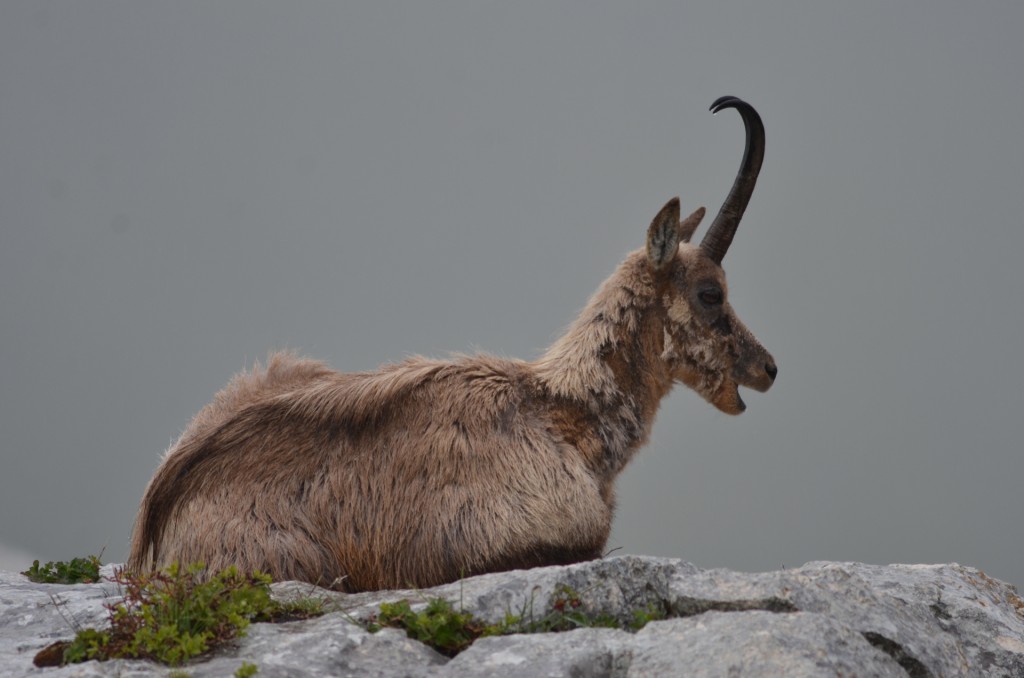
Abruzzi Chamois
The Abruzzi Mountains are home of the Marsican brown bear and Abruzzo Chamois. I went for a visit in may.
Intention: Find and photograph Marsican brown bear and Abruzzi chamois. Look for all other kinds of wildlife.
Duration of staying: may 25th to June 1st – 8 days
Weather: mild and pleasant most of the time, some rain, tendency of thunderstorms in the afternoon; some last pockets of snow in alpine areas
free ranging wild mammal species seen: 8
- Red deer (Cervus elaphus hippelaphus), german: Rothirsch;
- Roe deer (Capreolus capreolus), Reh;
- Abruzzi chamois (Rupicapra ornata), Abruzzengemse;
- European hare (Lepus europaeus), Feldhase;
- European red squirrel (Sciurus vulgaris), Eichhörnchen;
- Red fox (Vulpes vulpes toschii), Rotfuchs;
- Wild boar (Sus scrofa), Wildschwein;
- Beech or Stone marten (Martes foina), Steinmarder
not sure:
- European wildcat (Felis silvestris), Wildkatze;
- Polecat (Mustela putorius), Iltis
misses:
- Marsican brown bear (Ursus arctos marsicanus), Marsikanischer Braunbär;
- Italian wolf (Canis lupus), Wolf
Itinerary
May 25th
Arrive at Viletta Barrea after 3 days of driving with a private car from Southern Germany with Stops at Genua and Florence.
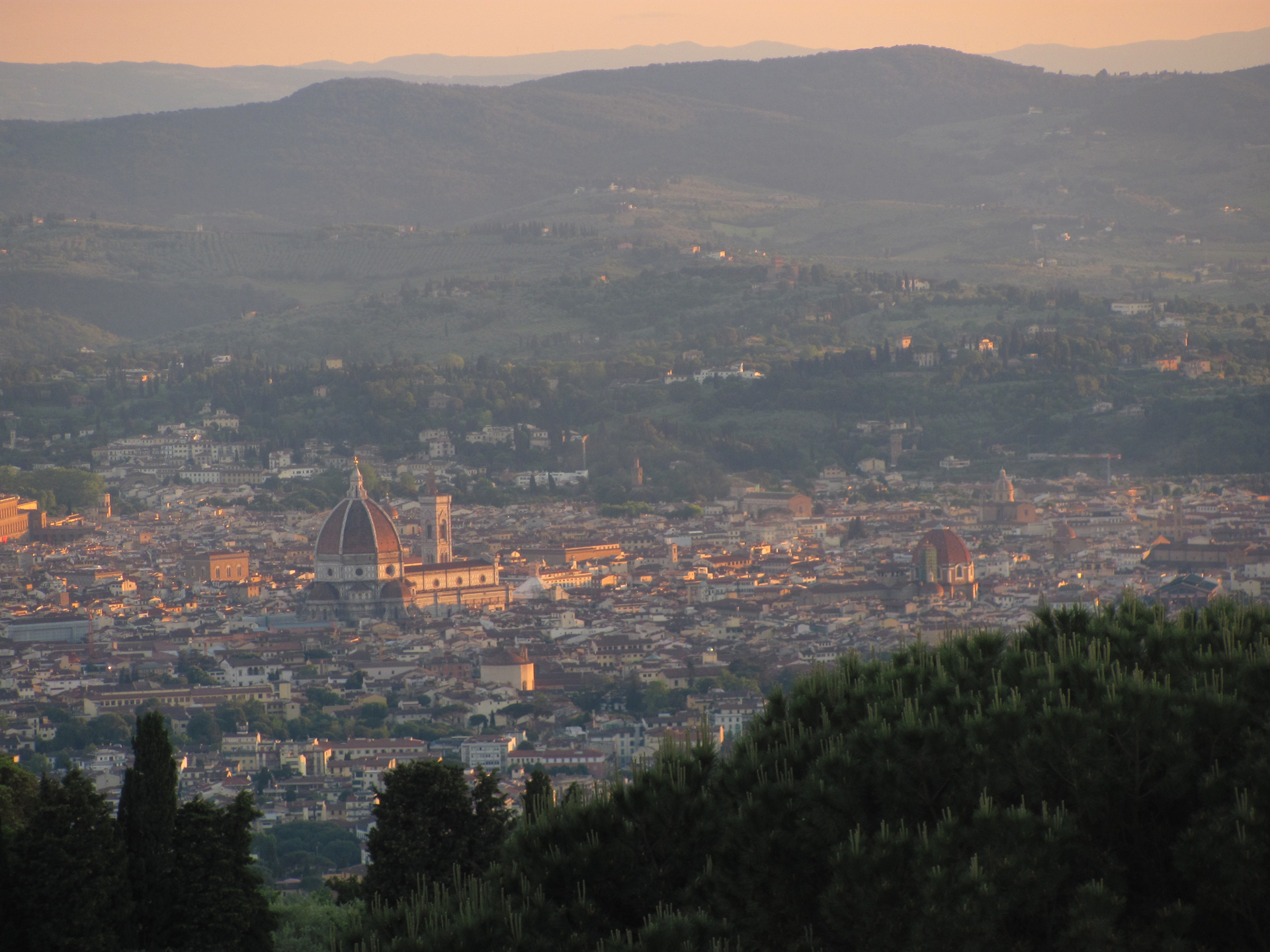
Florence with the „Duomo – Cattedrale Santa Maria del Fiore“
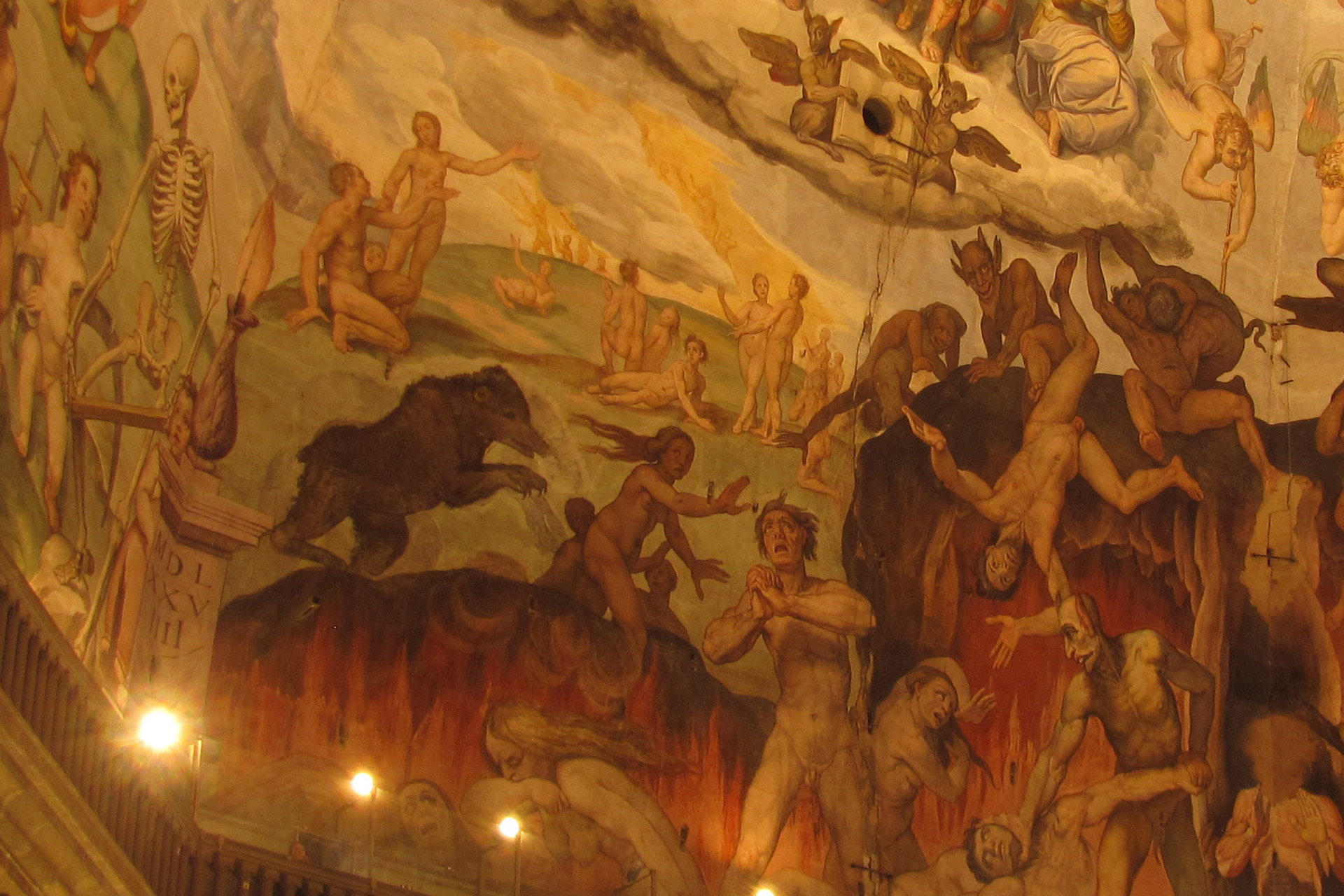
Inside the cupula: It was new to me that the bear was seen as a beast from hell. Note the person’s head in the left lower corner for size comparison!
Just before Pescasseroli a Red fox crosses the road. Before entering the village of Opi we see a Wild boar with 4 to 5 piglets 50 Meters above the road.
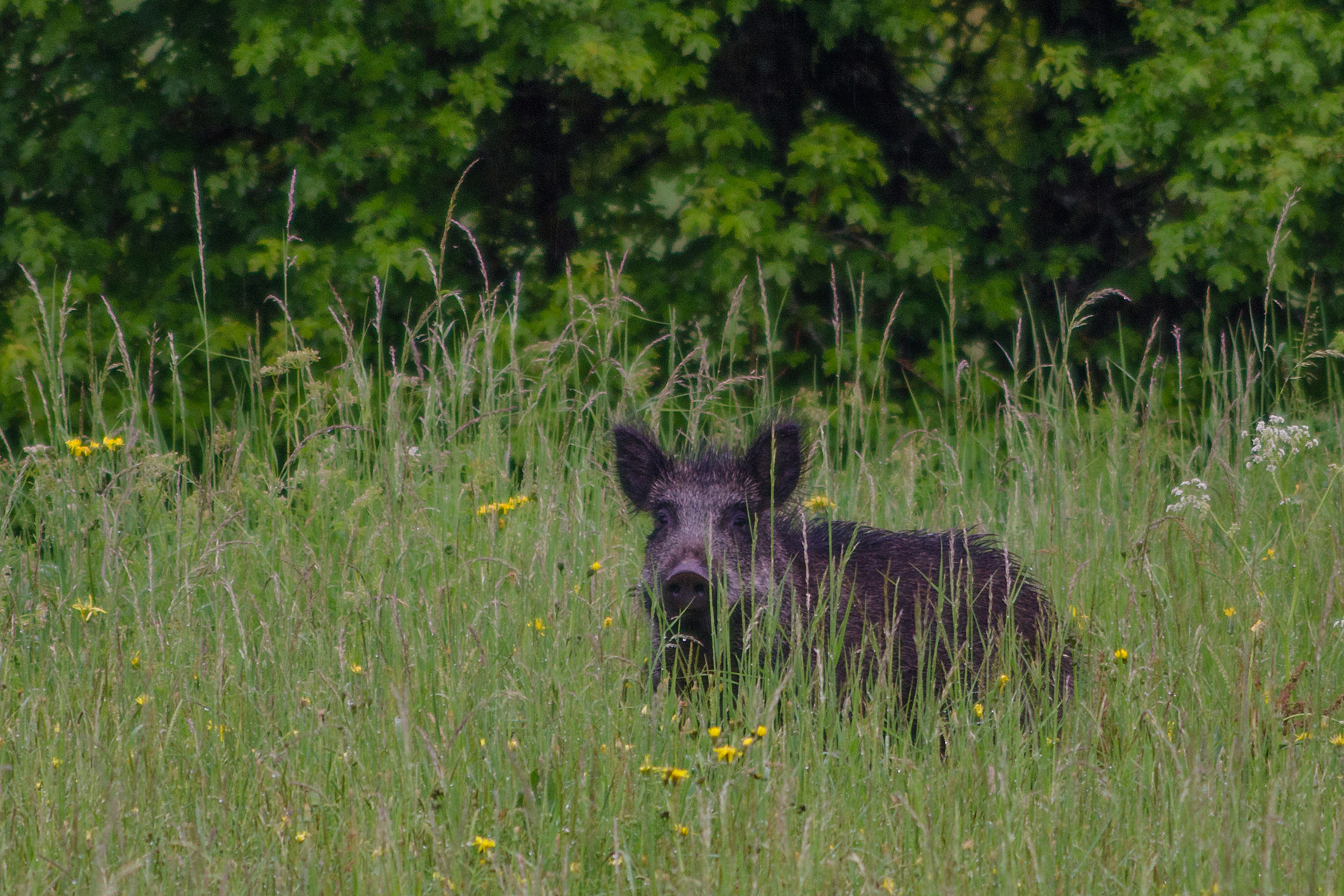
Wild boar
We stay at Casale delle Campitelle – www.agriturismocampitelle.it – a very nice „agriturismo“ outsite Viletta Barea. Leaving the car and looking at the westfacing slopes we detect instantly several female Red deer not far from the valley bottom.
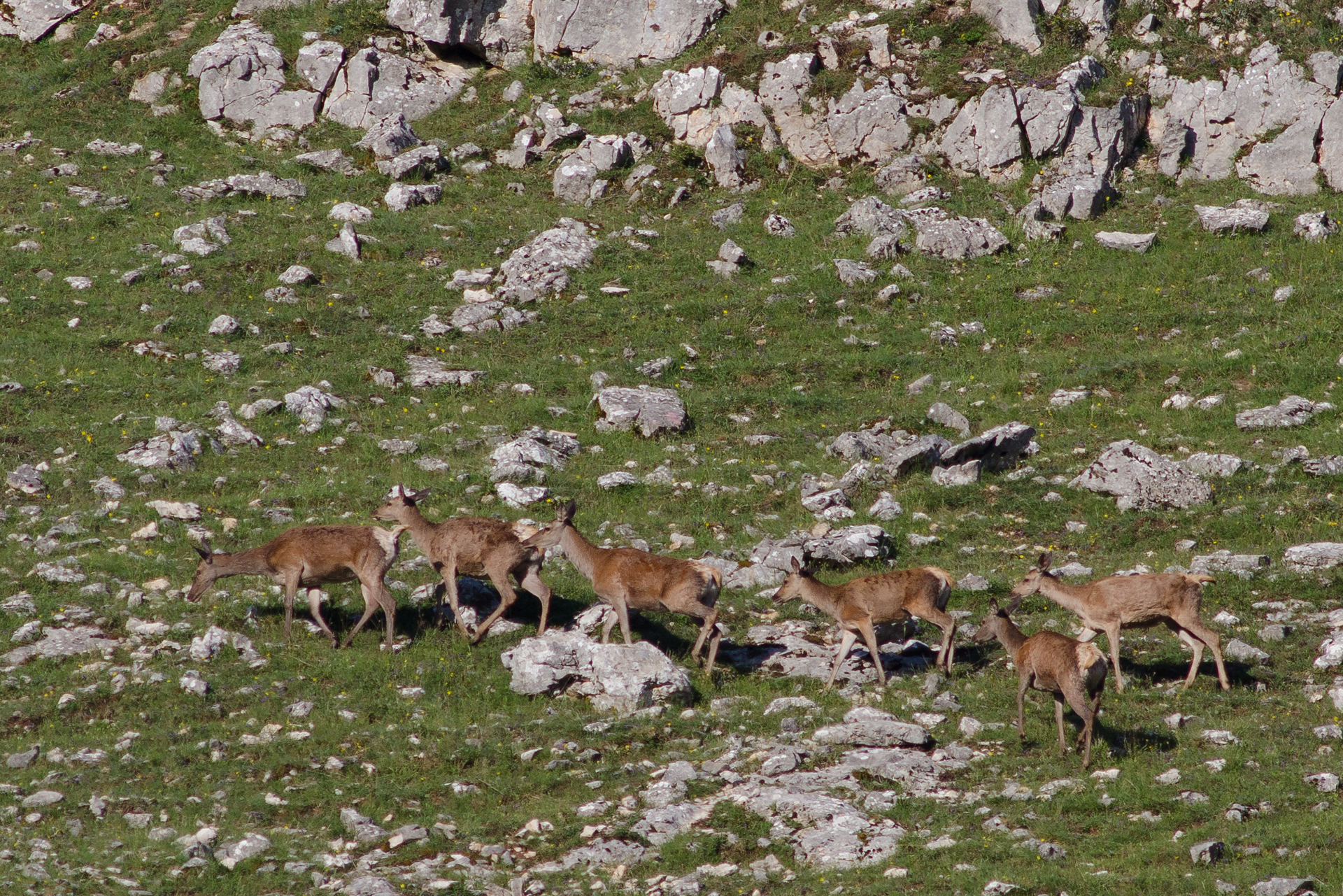
Female red deer
After initial hellos and having moved into our room we go for a little walk and run straight into a massive wild boar at close distance. Too close for comfort, but the boar shows no intention to wrestle with us.
May 26th
A roe deer sounds warning crys which pretty much sound like dog barking. Leaving the property in the morning a European hare crosses the dirt road.
Across the valley bottom near Opi we detect several mature male Red deer at a distance of about 200 meters.
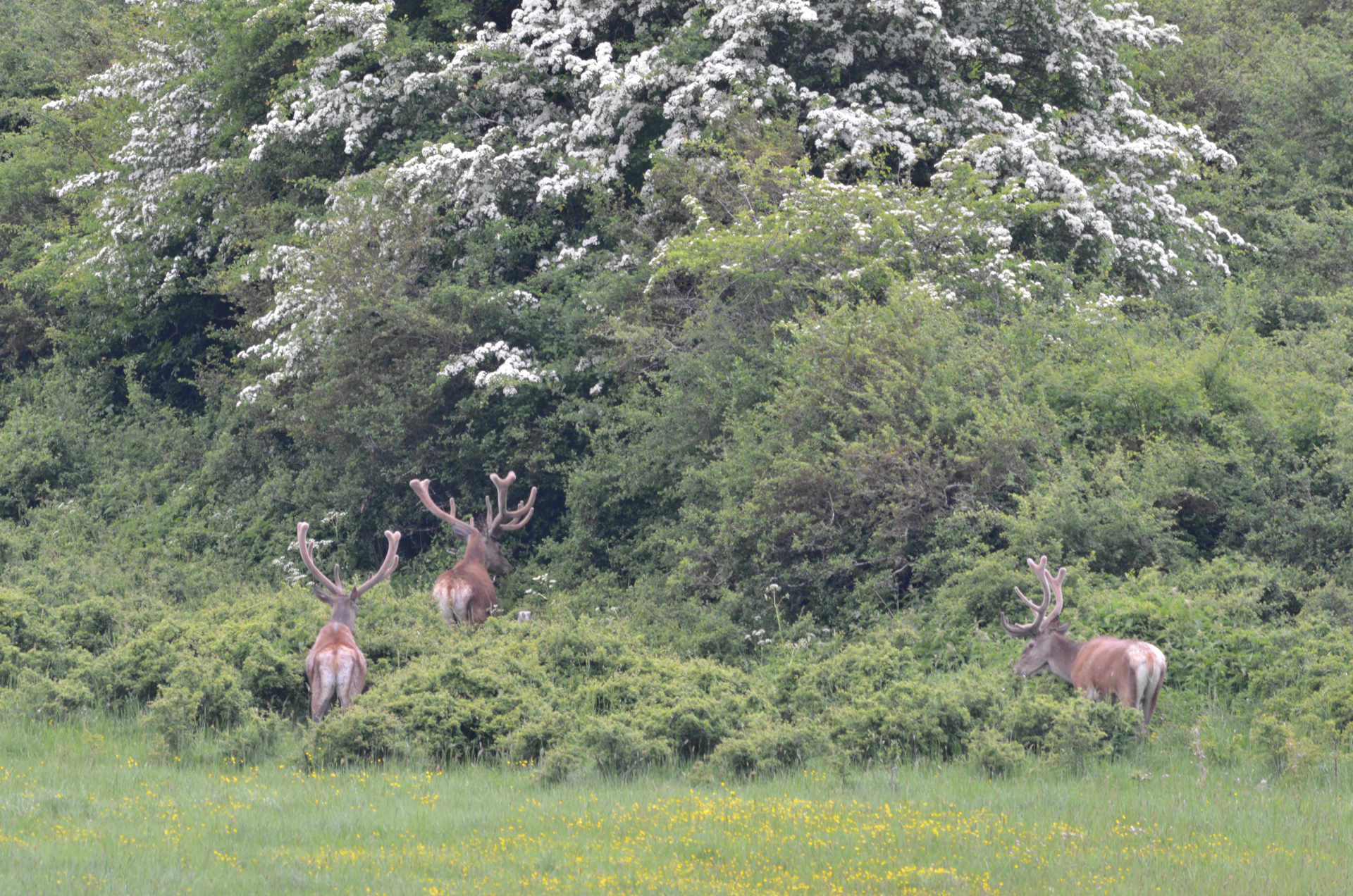
Red deer stags
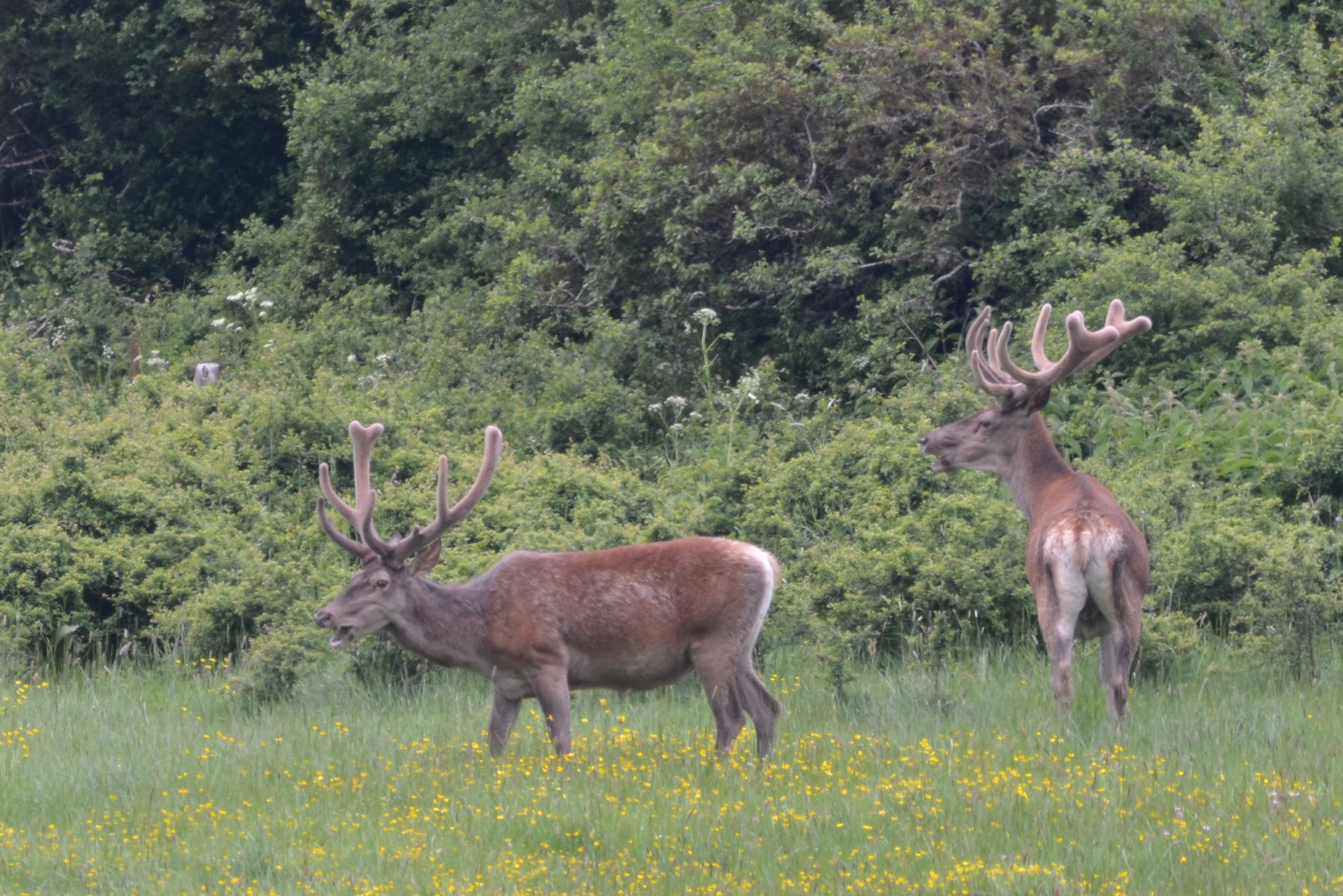
Very nice animals. Velvet still covering the antlers.
We visit the „parco faunistico“ in Pescasseroli. It is a little animal park in very bad shap with only a few animals left. The place can not be recommended. A single marsican brown bear shows some tricks with a stick.
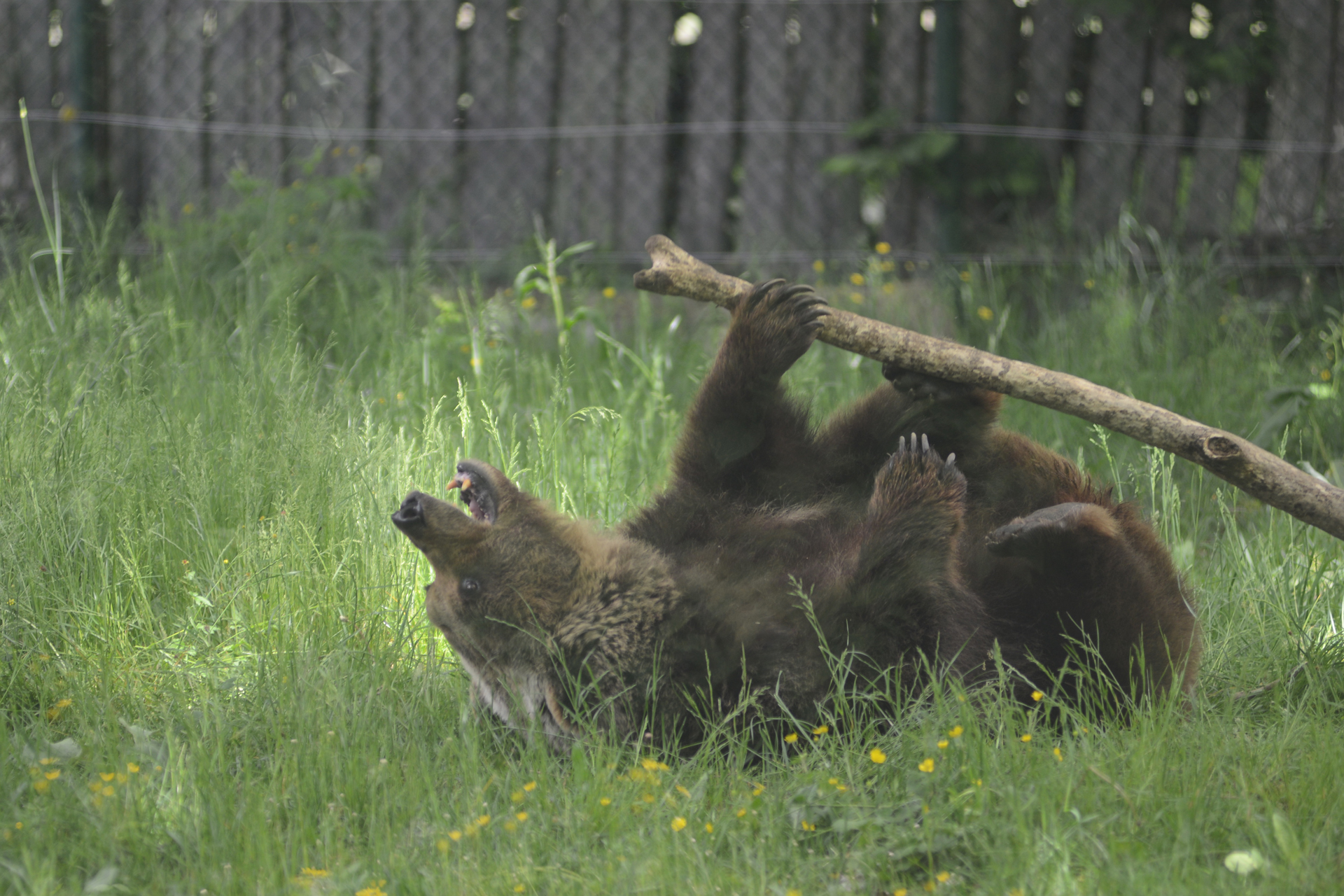
Marsican brown bear
In the afternoon I trek myself up Val di Rose. Just after having left the village of Civitella Alfedena and before entering the forest I stumple again into a wild boar mother with 7 to 8 piglets. This time I am even closer to the animals. The mother takes initiative and flees, the piglets following her – exept one, which tries to hide between the gras. But it is so close to me – 4 to 5 meters – so the hiding is useless. The small creature realises this and eventually follows its family.
On the way up through the forest there are some open places. At one of these I find a female Red deer with a calf – very idyllic.
I have barely left the upper forest line behind me, when my first Abruzzi chamois comes into view resting elevated on a rock.
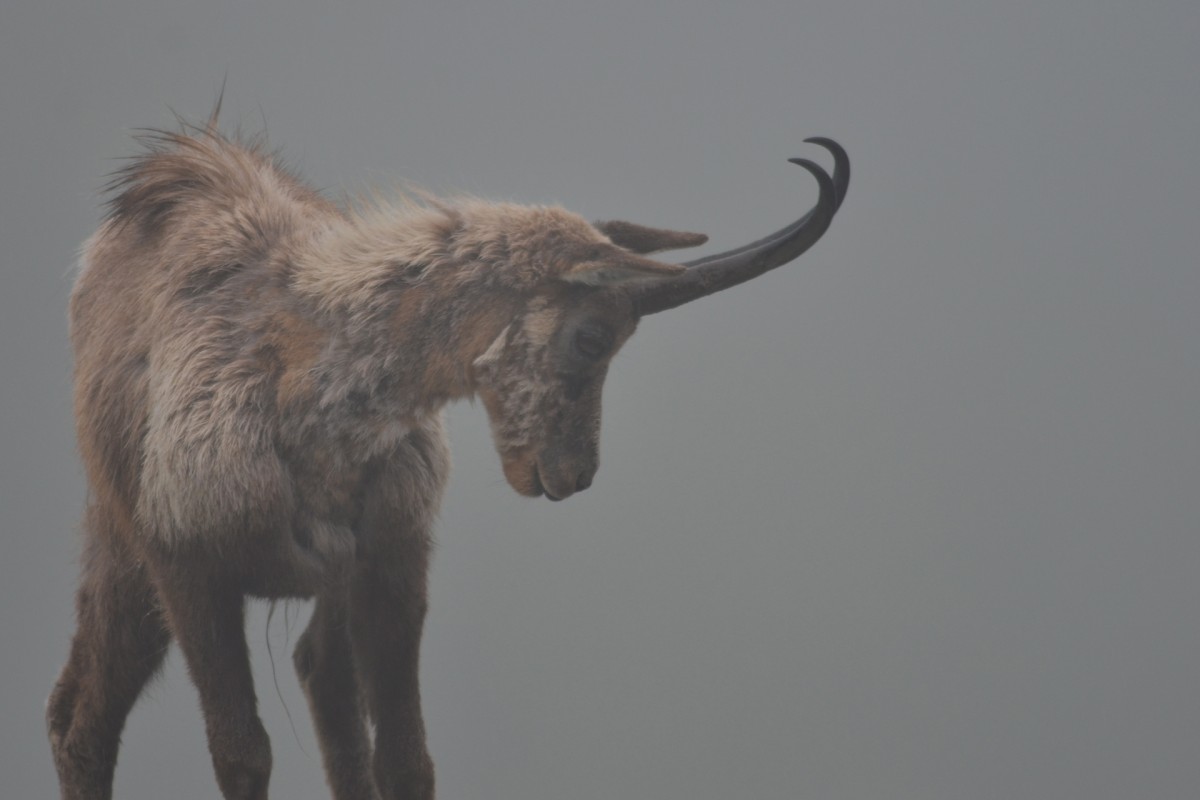
Abruzzi Chamois
But at the same time mist ascends from the valley below and covers the scenery. I still manage to take a few portraits, which show that the so called „camosci la più bella del mondo“ (most beautiful chamois in the world) has times, when it is not so beautiful – during change of coat.
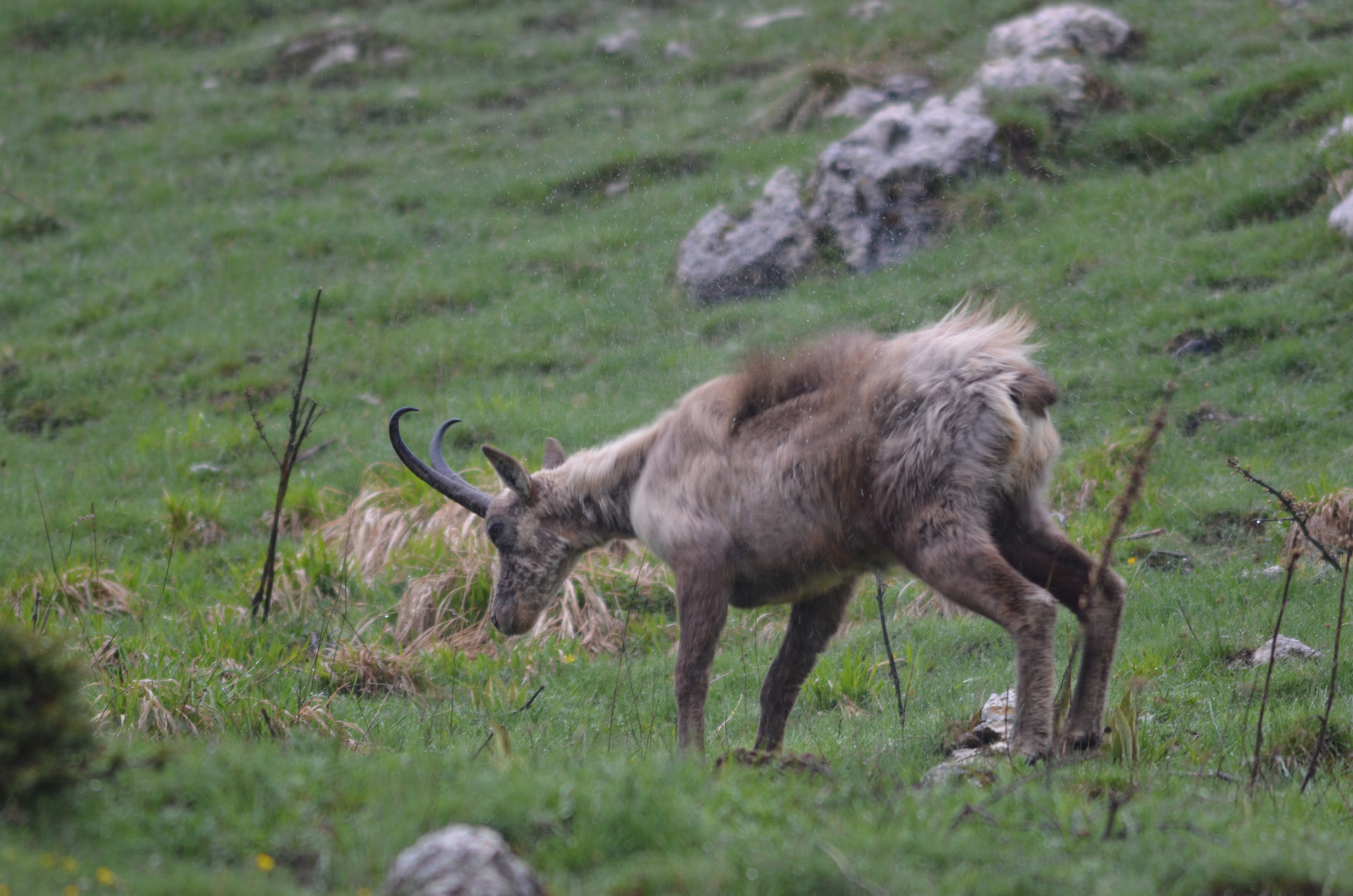
Chamois – shaking off loose hair
May 27th
Wonderful morning with birds all around. Havn’t barely opened my eyes, I start photographing from the window of our room with my 800mm-lens:
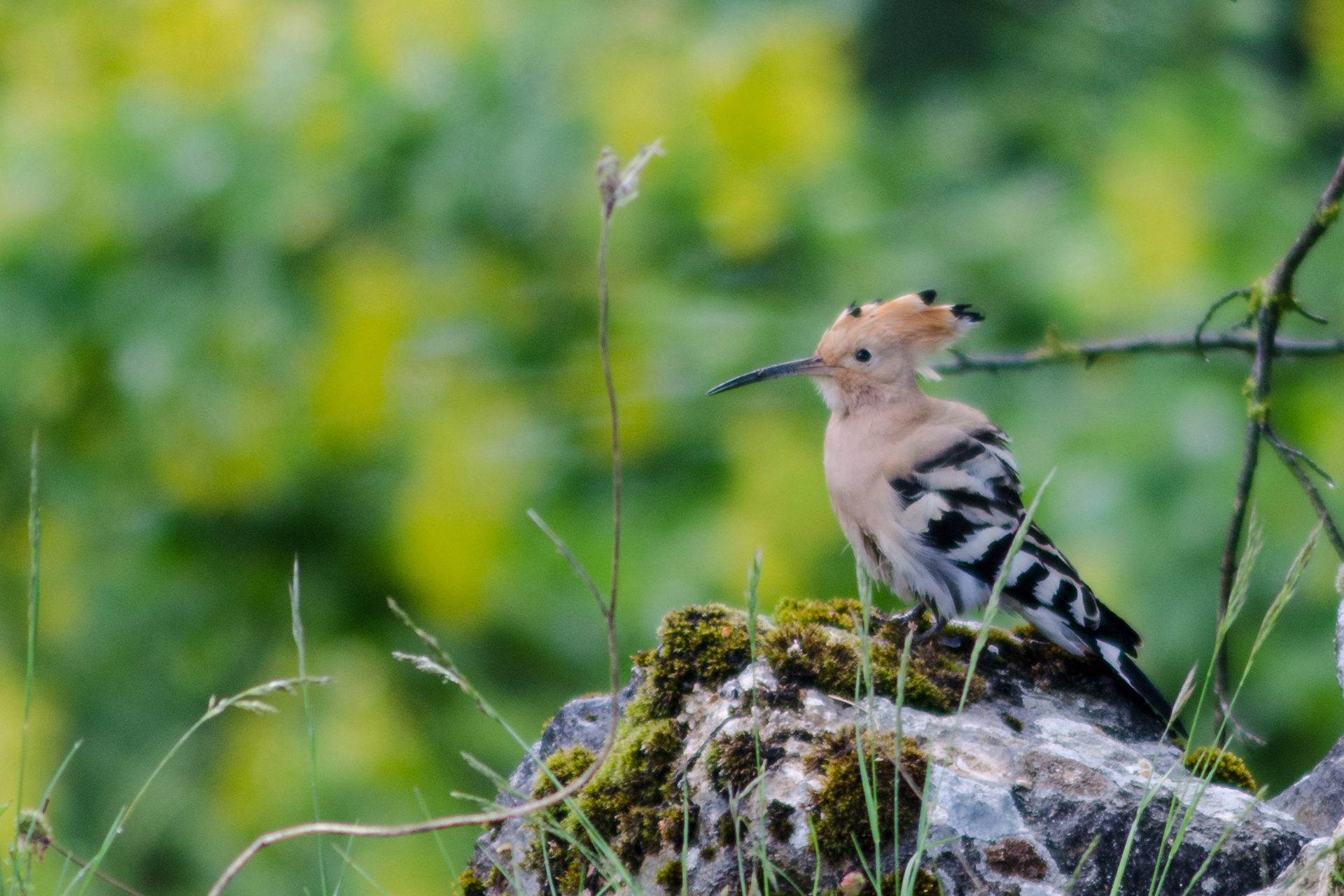
Hoopoo (Wiedehopf)
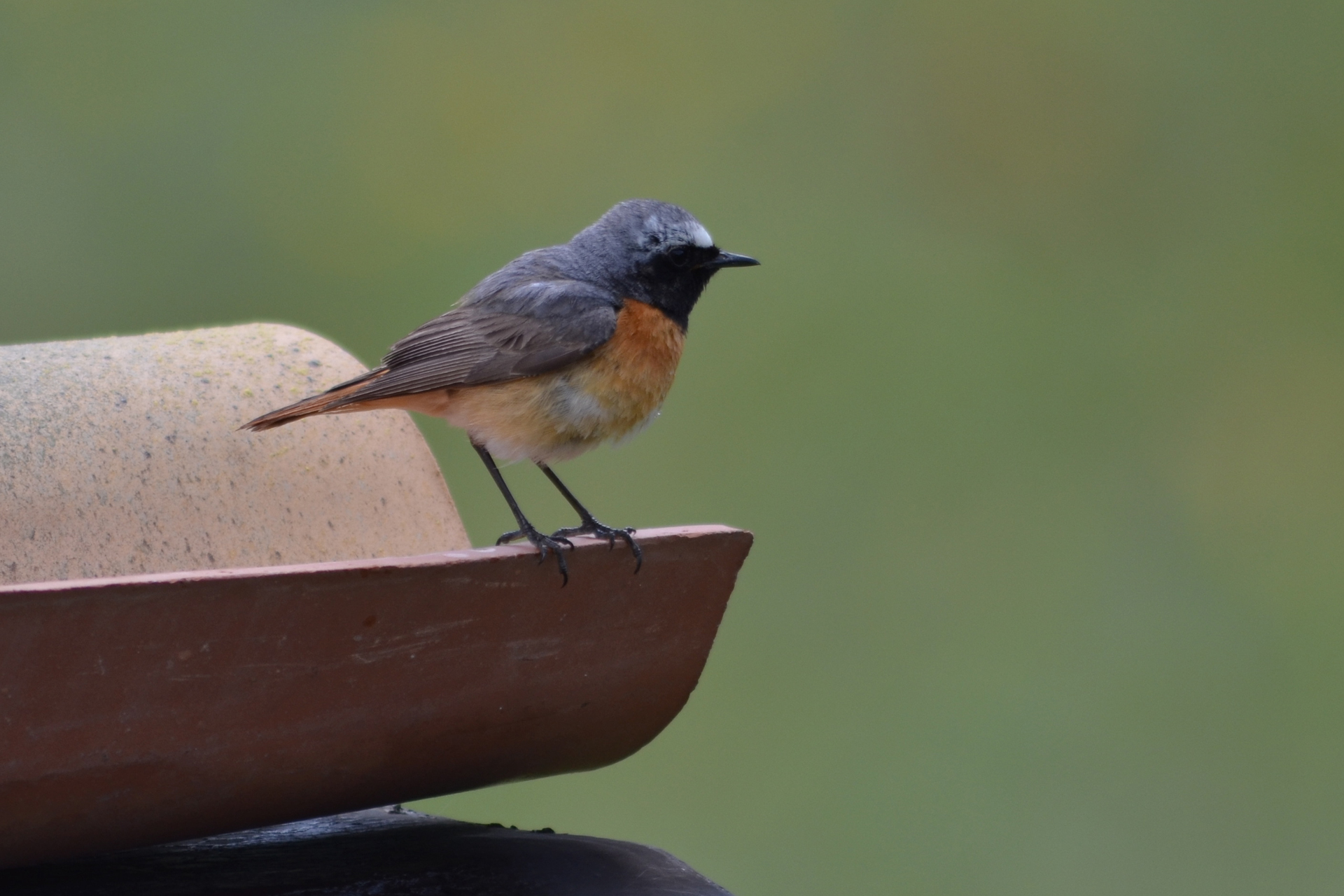
Common redstart (Gartenrotschwanz)
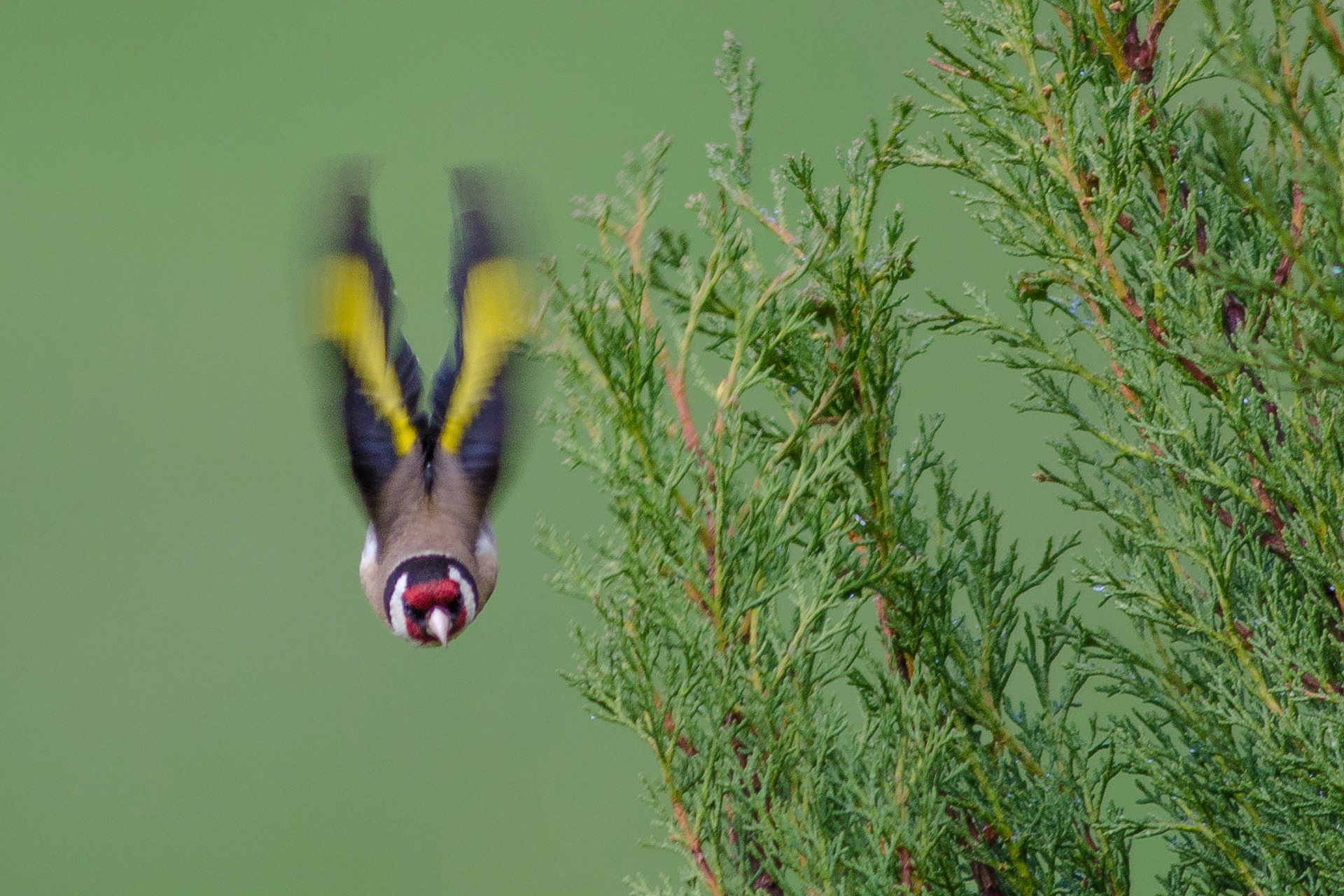
European goldfinch (Distelfink)
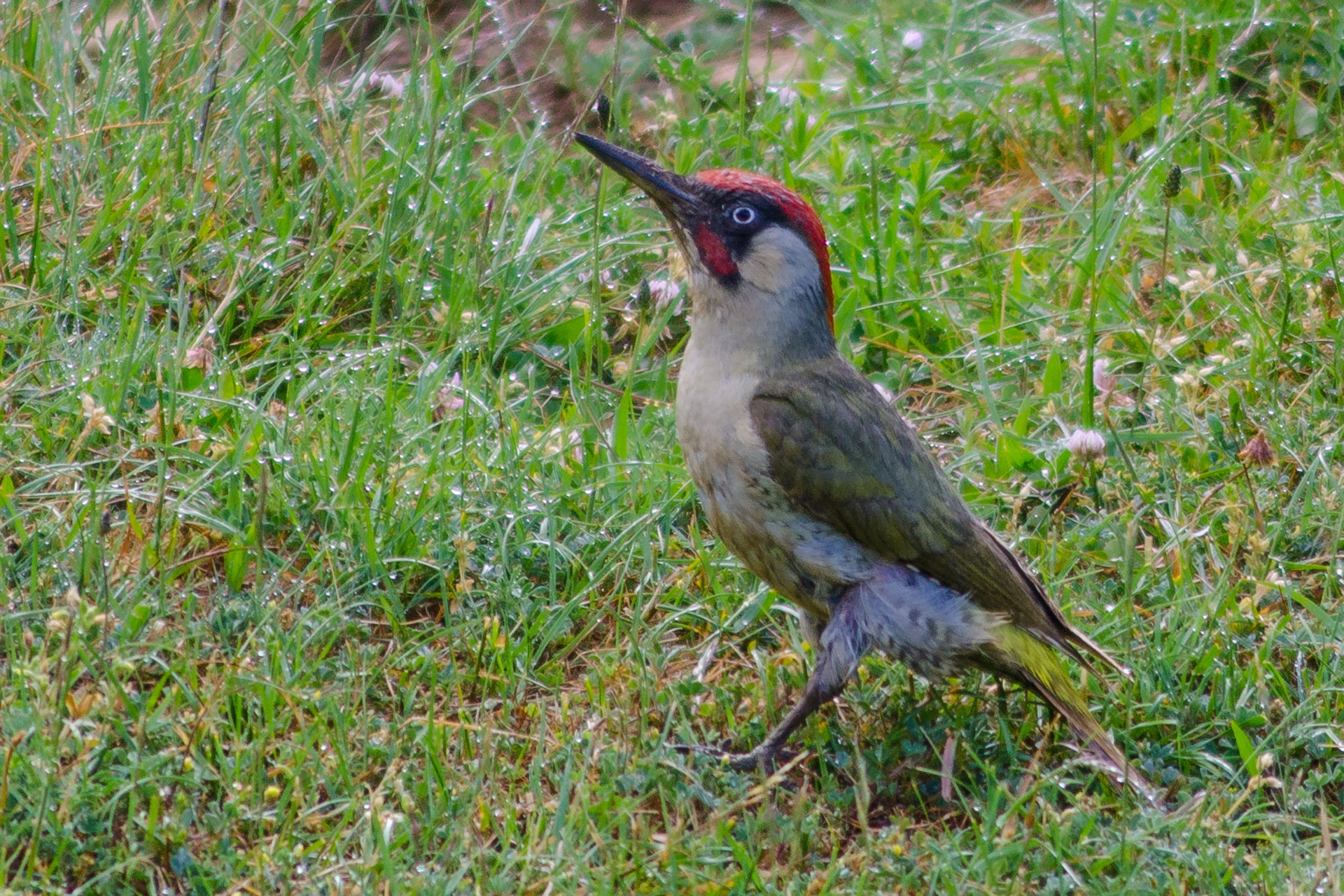
European green woodpecker (Grünspecht)
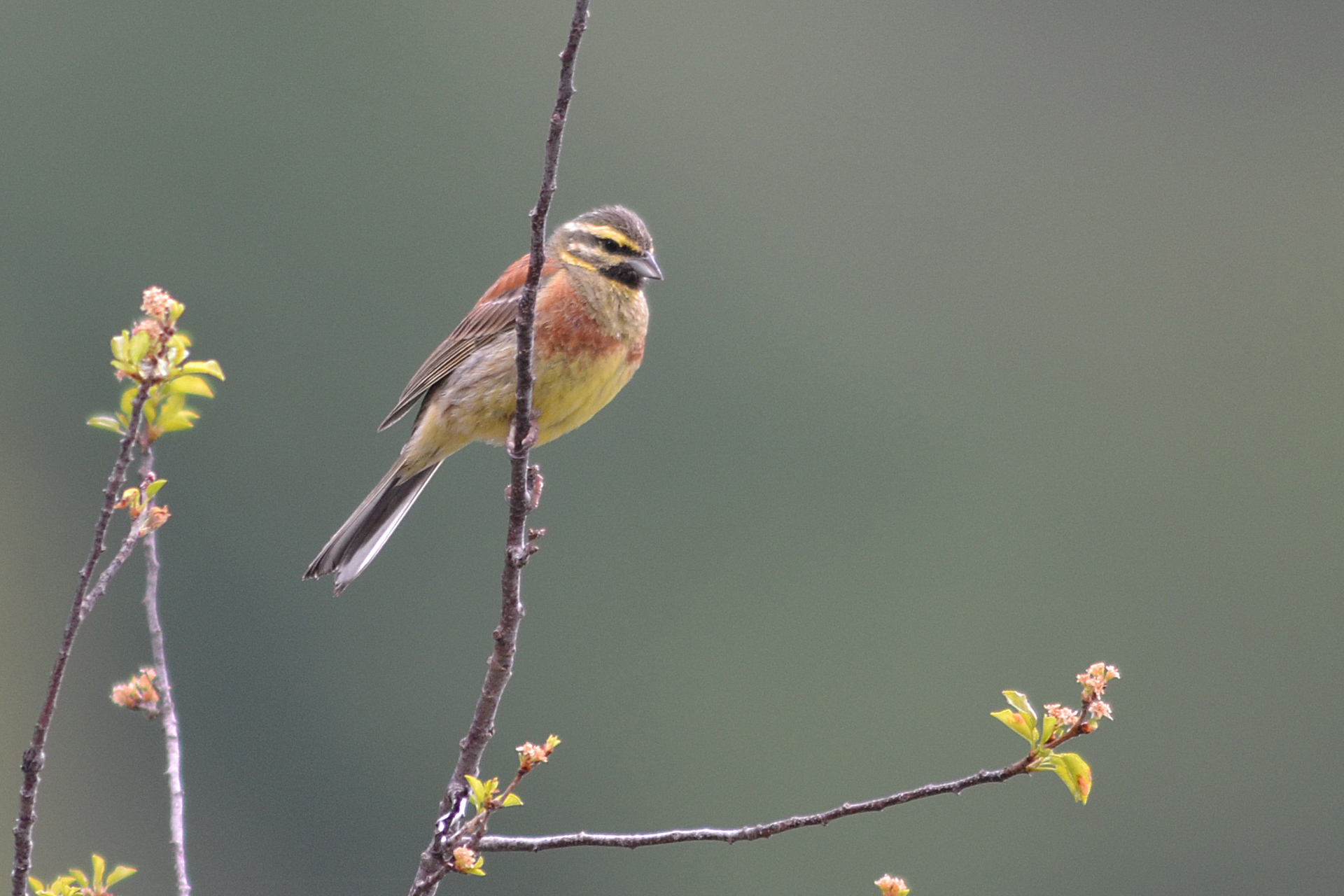
Cirl bunting (Zaunammer)
I detect a salt lick close to our place, where red deer gather. It is in sight distance to Casale delle Campitelle, below the road SS479 that leads from Villetta Barrea to Godi Pass.
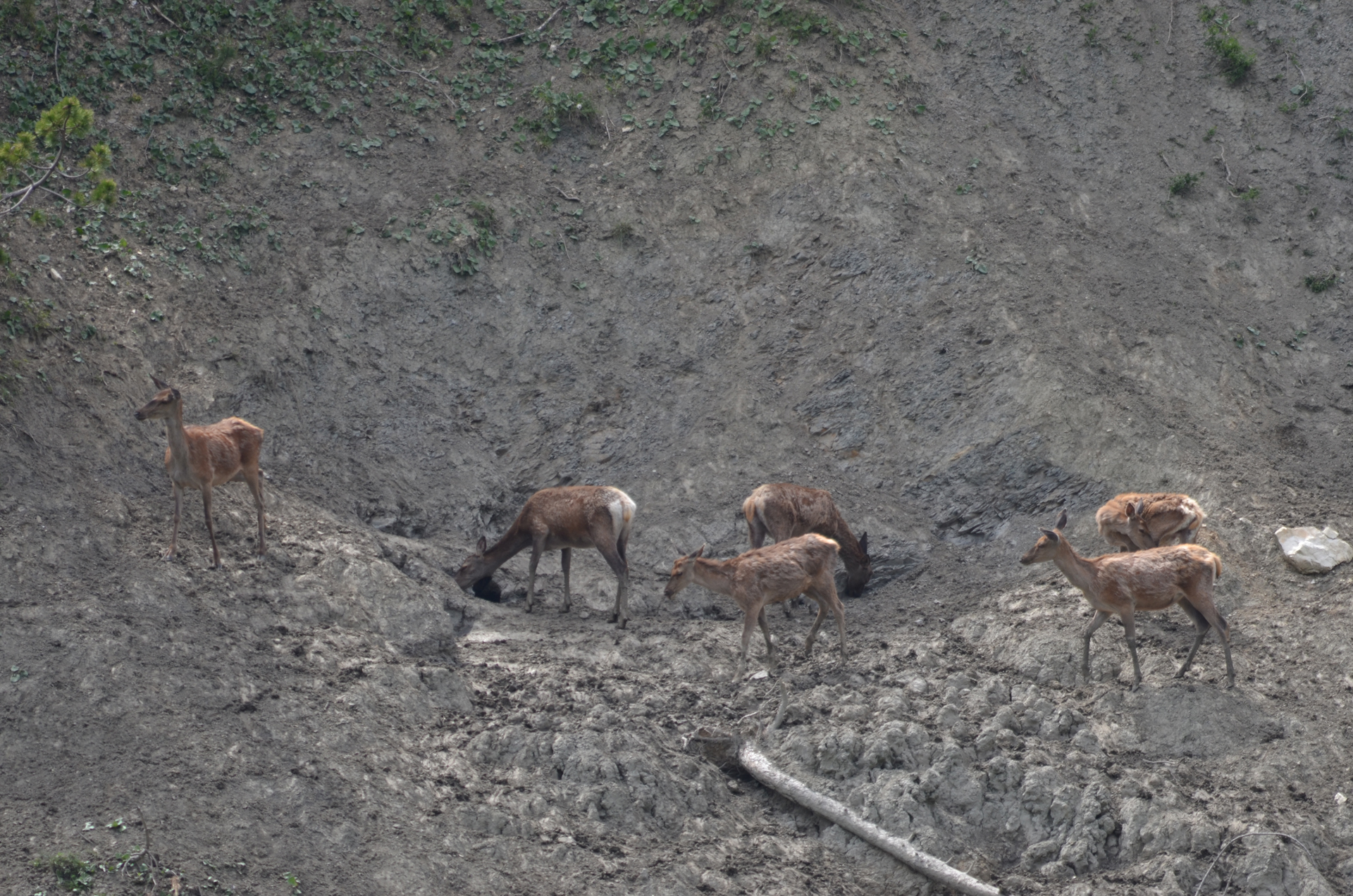
Red deer at salt lick
Go on a guided bearwatching tour with Paolo Iannicca, Ecotur, from Pescasseroli.
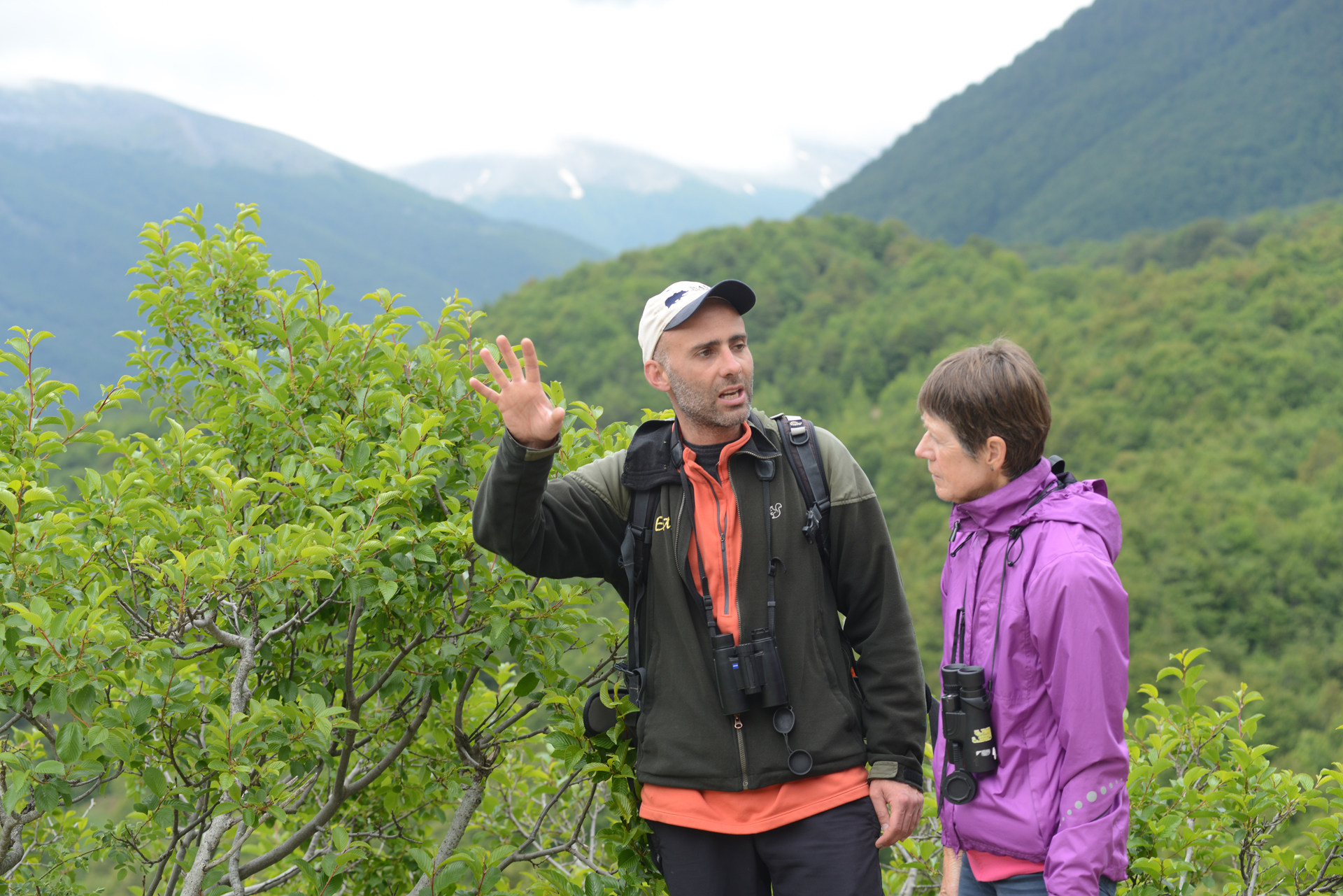
Paolo Iannicca: our fabulous guide
We are four in the group including a couple from the Netherlands. Paolo – very matching wearing a black and white cap with the inscription „Save the Marsican Bear“ – tells us that there are 60 bears left in the Abruzzi Mountains, 90 percent of them are inside the National Park. Some of them occur in the Maiella mountains.
Best times to see the bears is May and August to September, Paolo says. In May chances are good to see them in the valley buttoms, where they simply feed on grass. They also like chicory (Cichorium intybus, Wegwarte).
Later in the year, during August and September, chances to see them are again good above treeline (1800 m) when berries oft he Alpine buckthorn (Rhamnus alpina, Alpen-Kreuzdorn) are ripe. A problem at this period can be fog that sticks around the mountain tops.
In autumn the Marsican bears take beechnuts (Bucheckern) and apples. During winter, Paolo explains, bears sometimes interrupt hibernation to feed on rose hips (Hagebutten).
Paolo leads us into a remote valley north of Pescasseroli. He states number of bears (around 50) is stable, but the subspecies of the European Brown bear is still endangered. Not everybody loves the bears. They make some damage, but 70 percent is done by wolves. In Paolos view the three most important conservation measure are prevention, compensation and tourism.
We come by a sign which is knocked over. Paolo picks it up and takes a close look. Sure enough he finds one: a hair.
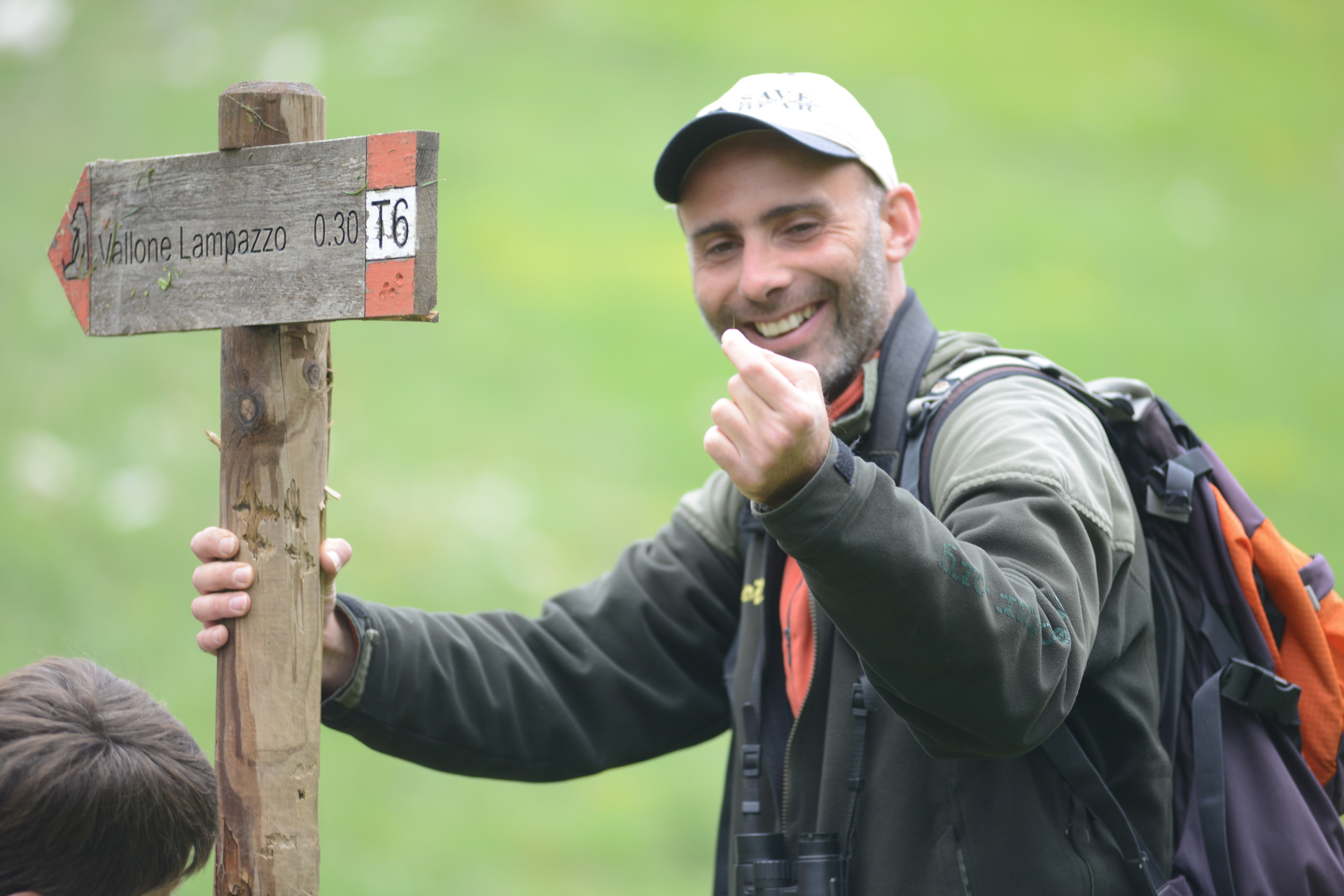
A bear was here, this is the proof: a single hair
A bear must have scratched its back at the pole which then gave way.
We reach the end of the valley, where Paolo shows us a place where park employes used to catch bears with snares. Branches are arranged in a way that through coming bears are forced to set their paws at certain spots. At one of this spots the snare is outlaid and camouflaged. According to Paolo one bear, Valerie, was caught here 3 to 4 times.
Paolo is a communication expert by training. His customers come from Italy, England, France, Netherlands and Belgium. Group size maximum is 10. He also engages with bear monitorings organized by park personal. His bear guiding season starts in April, but he guides all year round. Paolo says: „The quality of your tours is better, when you guide constantly. Imagine a bartender making coffee only in august. Chances are, you get only black water.“
We go back to the car and drive to a lookout near Gioia vecchio, an abandoned village, where we spent the evening. We don’t see a bear, but instead red deer and a Golden eagle.
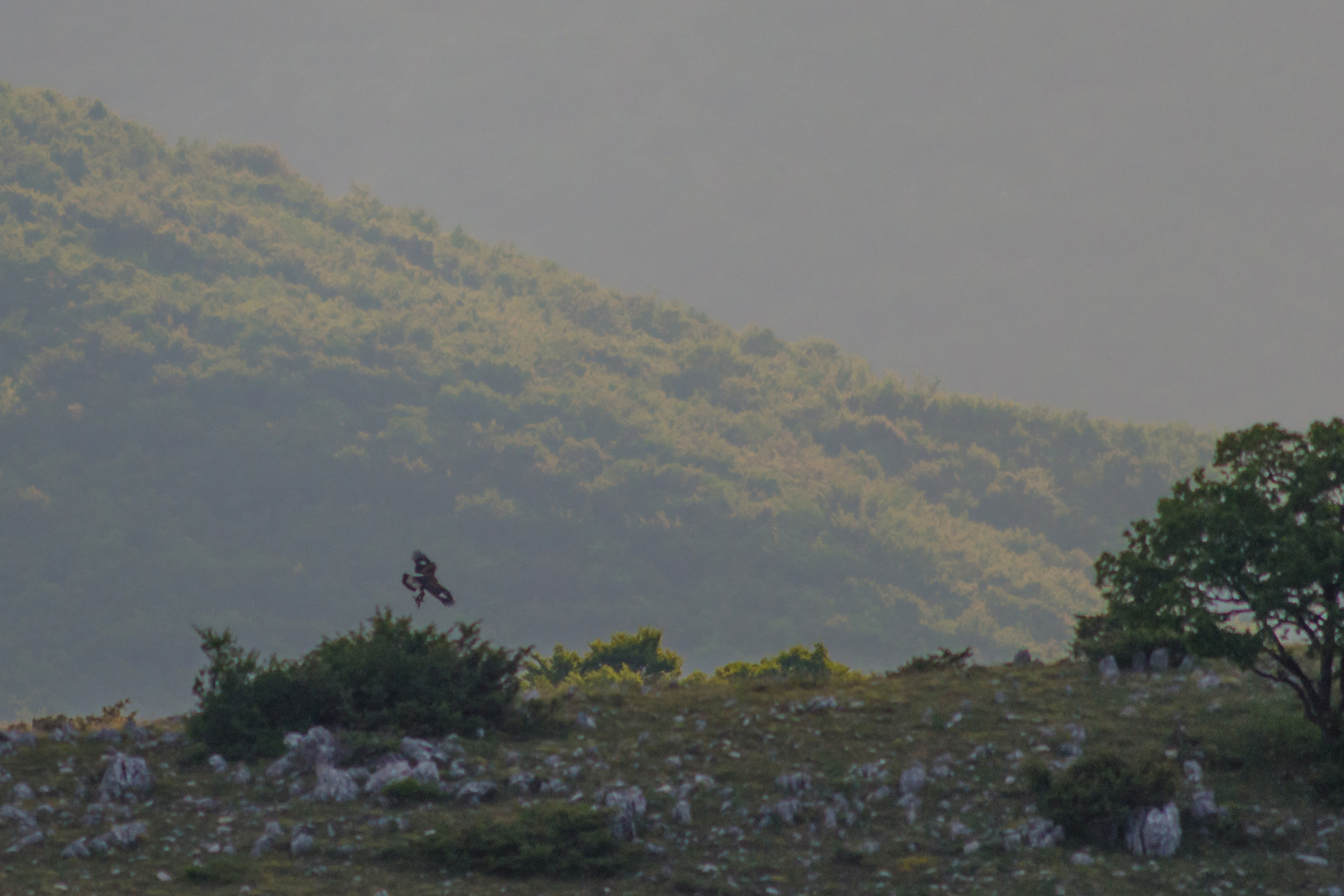
Golden eagle with prey (not identified)
May 28th
I start early and try again for the bears at Gioia vecchio. On the way I find a red deer at the southern outskirts of Pescasseroli. I stand on my lane while the deer feeds on a bush on the opposite roadside. Three to four meters away, the deer shows no fear at all!
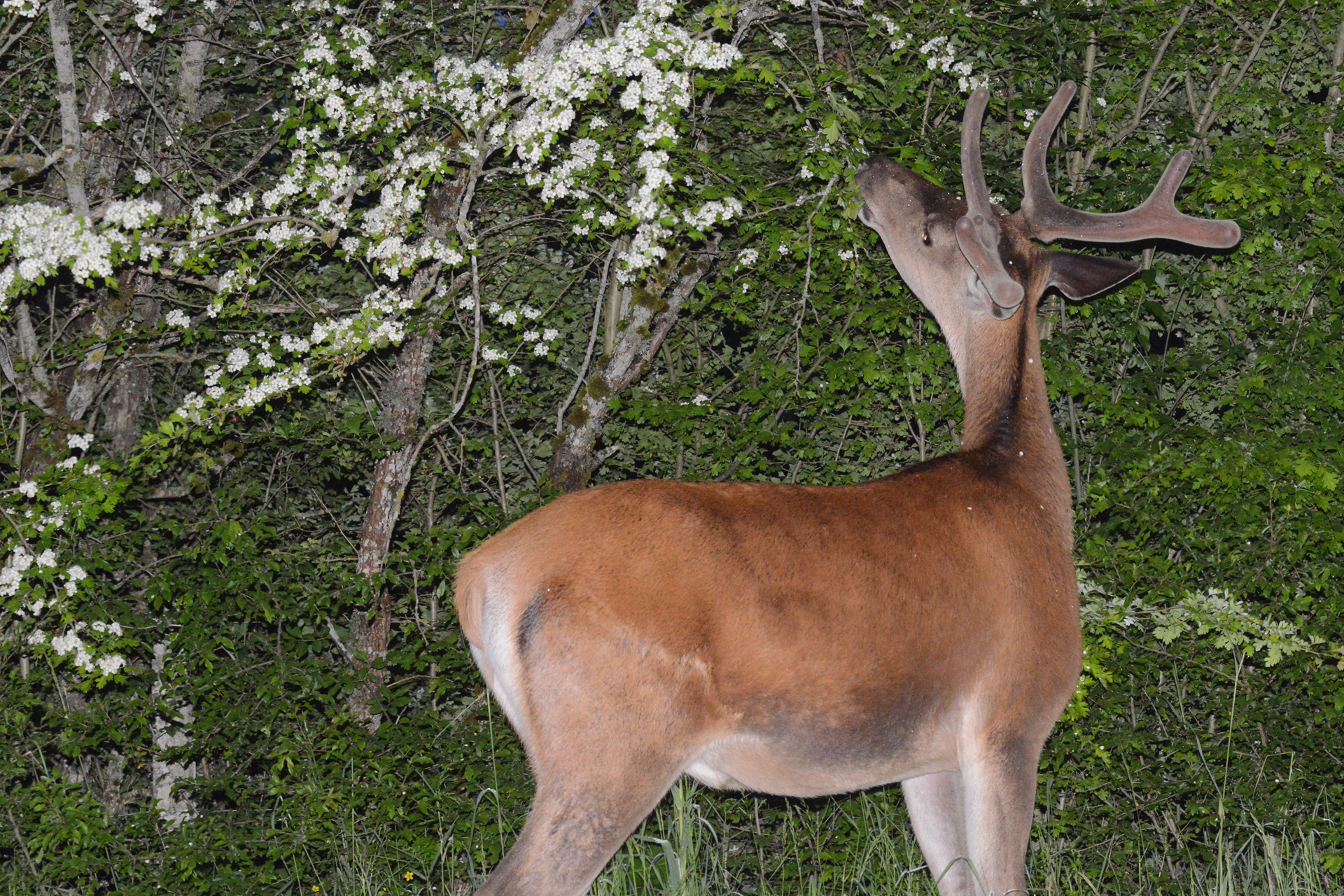
Red deer at road side with no fear at all
See a hare along the road behind Pescasseroli.
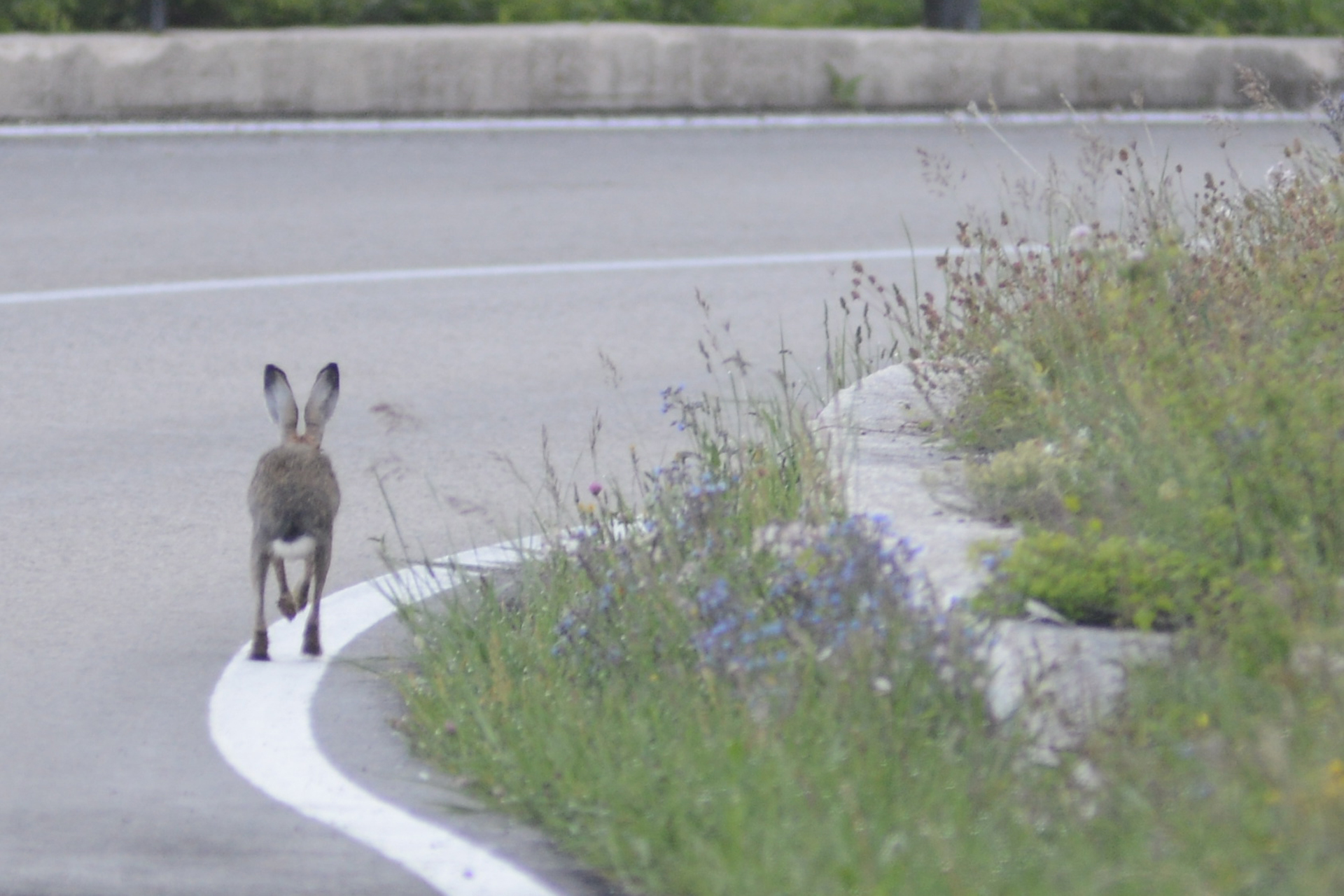
A European hare tracks properly.
Later that day I go with my family on a trip to fabulous Barrea, a settlement like smurf village with mazy alleys.
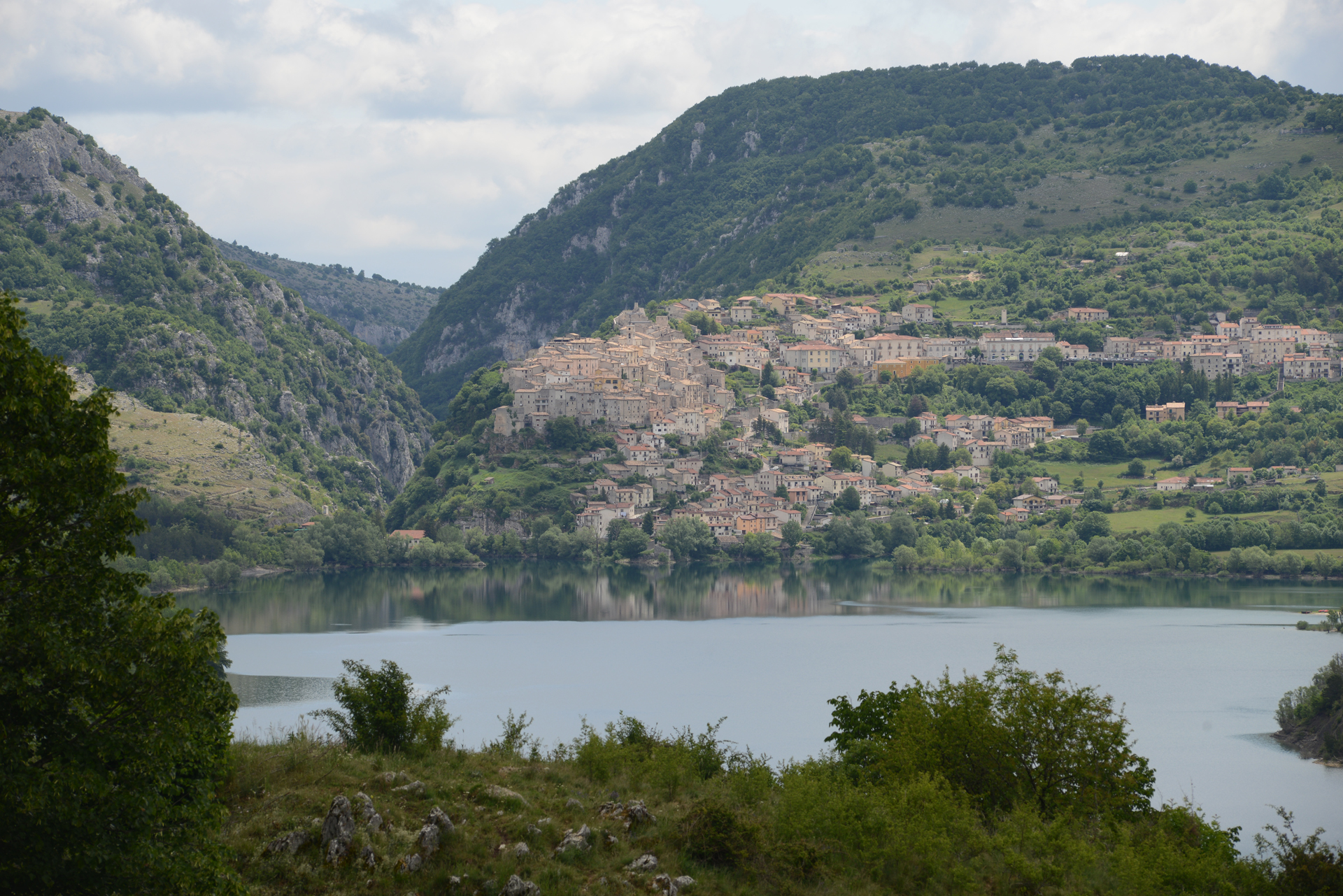
Idyllic Barrea
May 29th, Friday
Try again for bears in the valley north of Pescasseroli
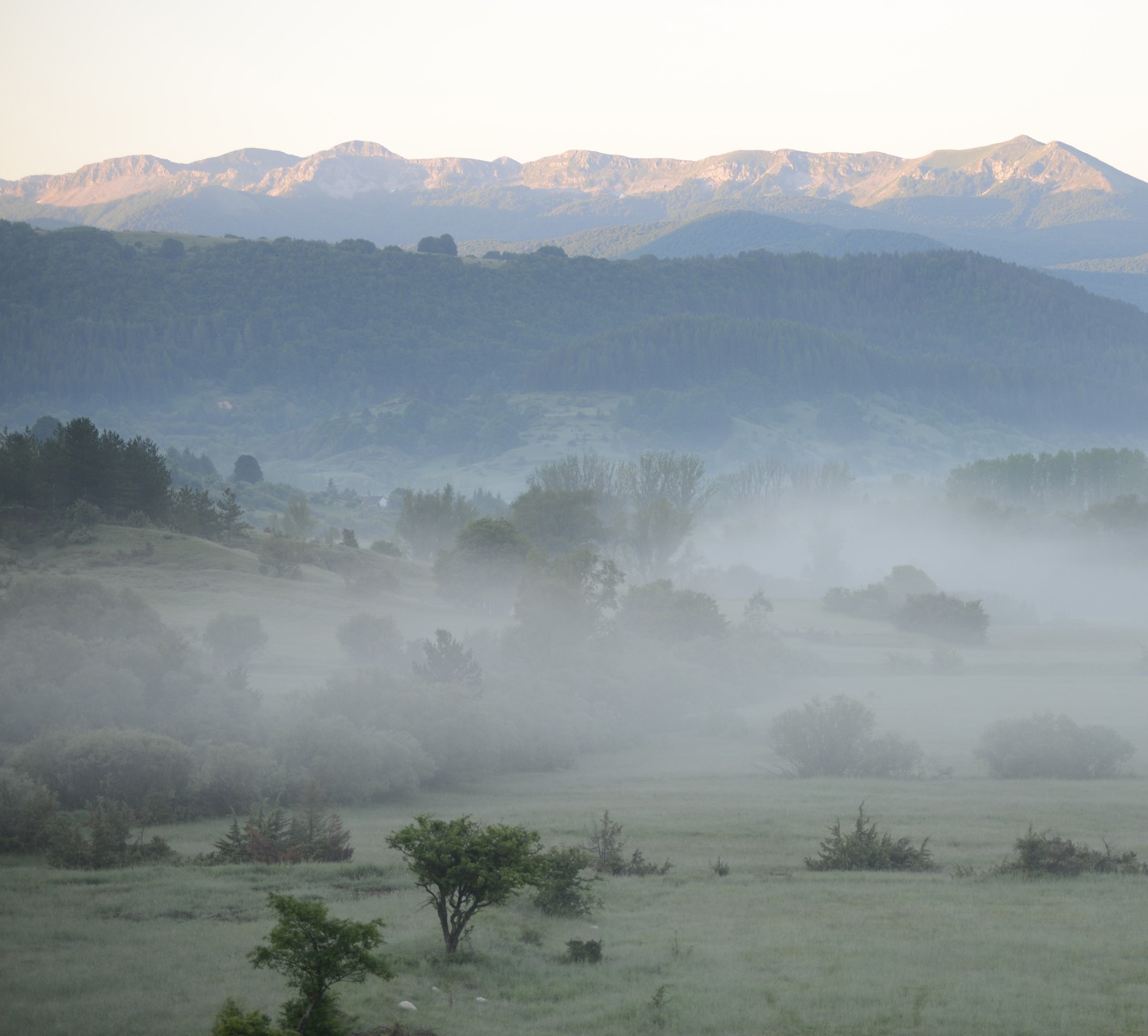
The Sangro valley, north of Pescasseroli: good place to look for wildlife
and at Gioia vecchio. No luck. See a fox along the road north of Pescasseroli.
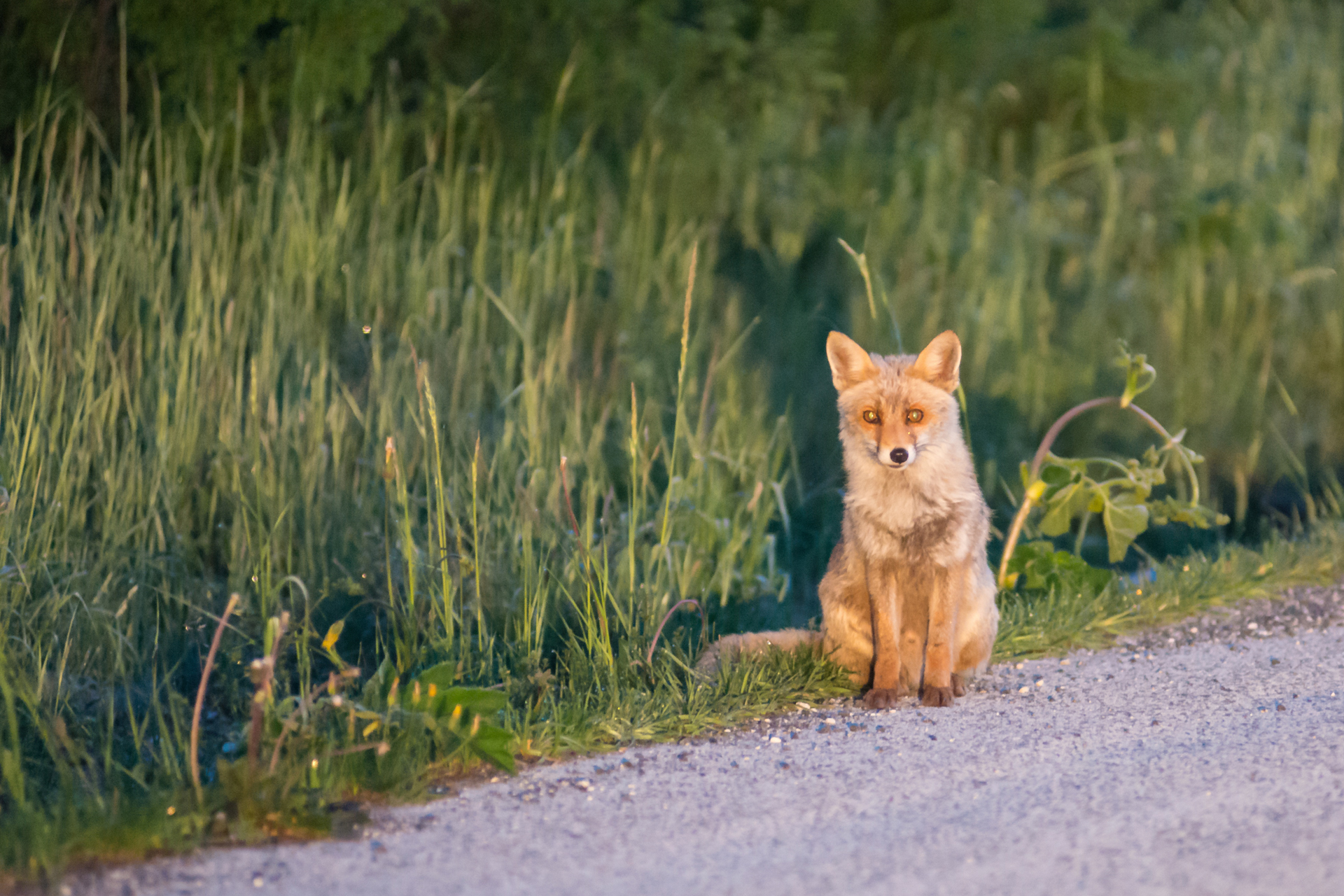
Red fox waiting curiously in the beam of my headlight.
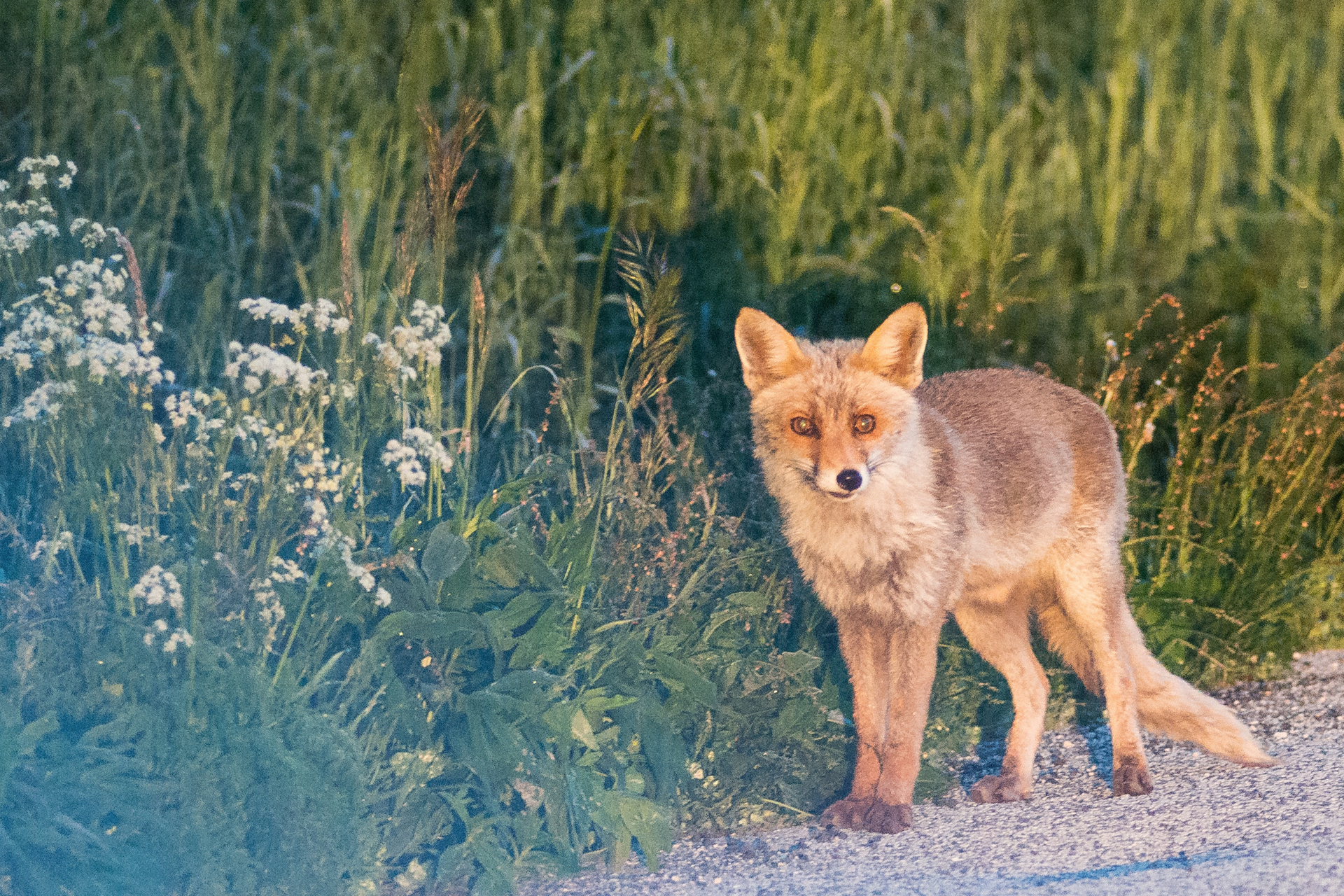
See my first roe deer from the lookout at Gioia vecchio on the opposite slope. While Red deer is more abundant, it takes a while to find the solitary roe deer.
On the way up from Villetta Barrea to Civitella Alfedena a Red Squirrel leaps up the berm. We visit the wolf enclosure at Civitella Alfedena, which has an acceptable size and a quasi-natural vegetation.
At Val di Rose once more: We see chamois again, but only in small numbers.
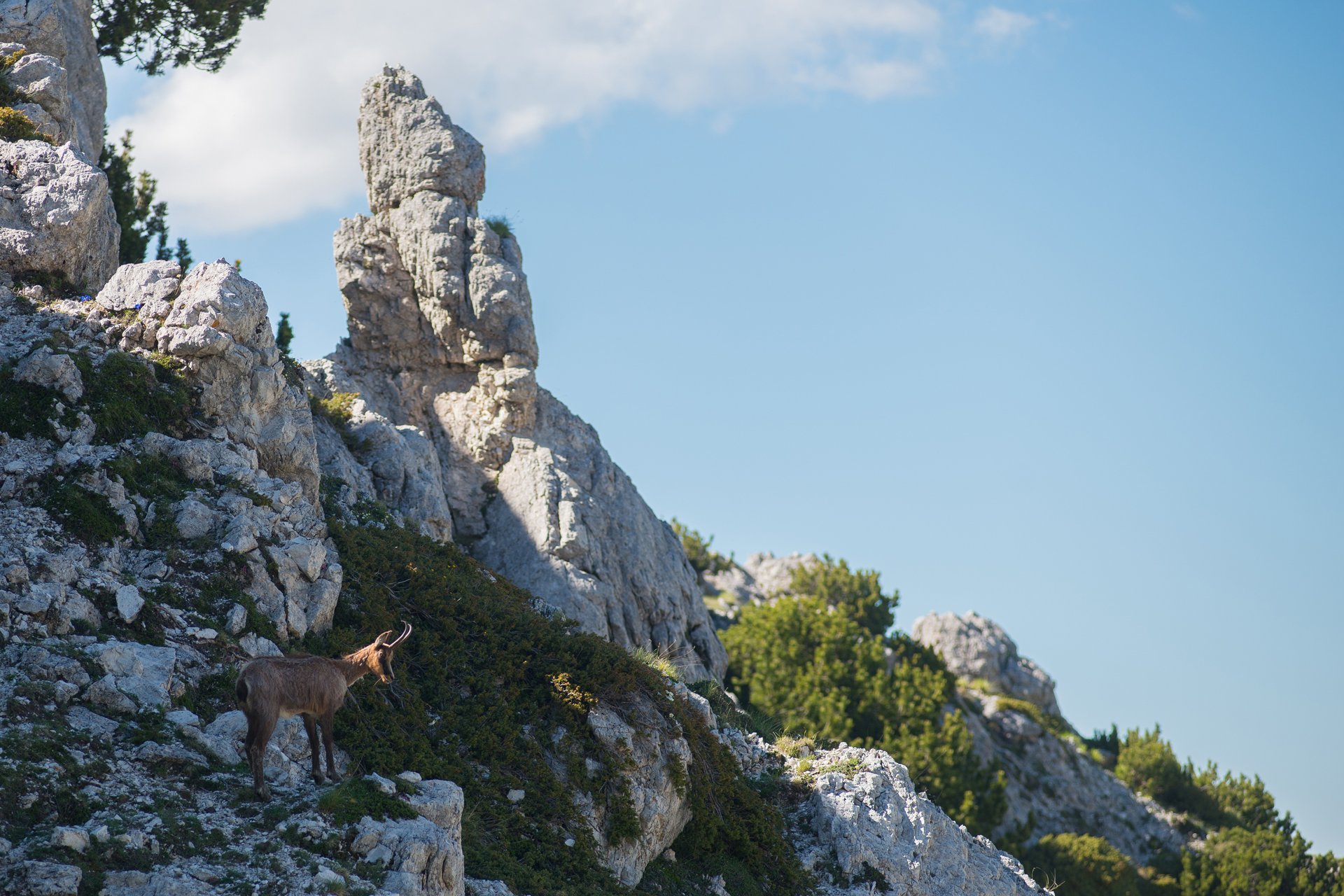
Abruzzi chamois in its habitat made of limestone columns
On the way down I surprise two female red deer on a little meadow.
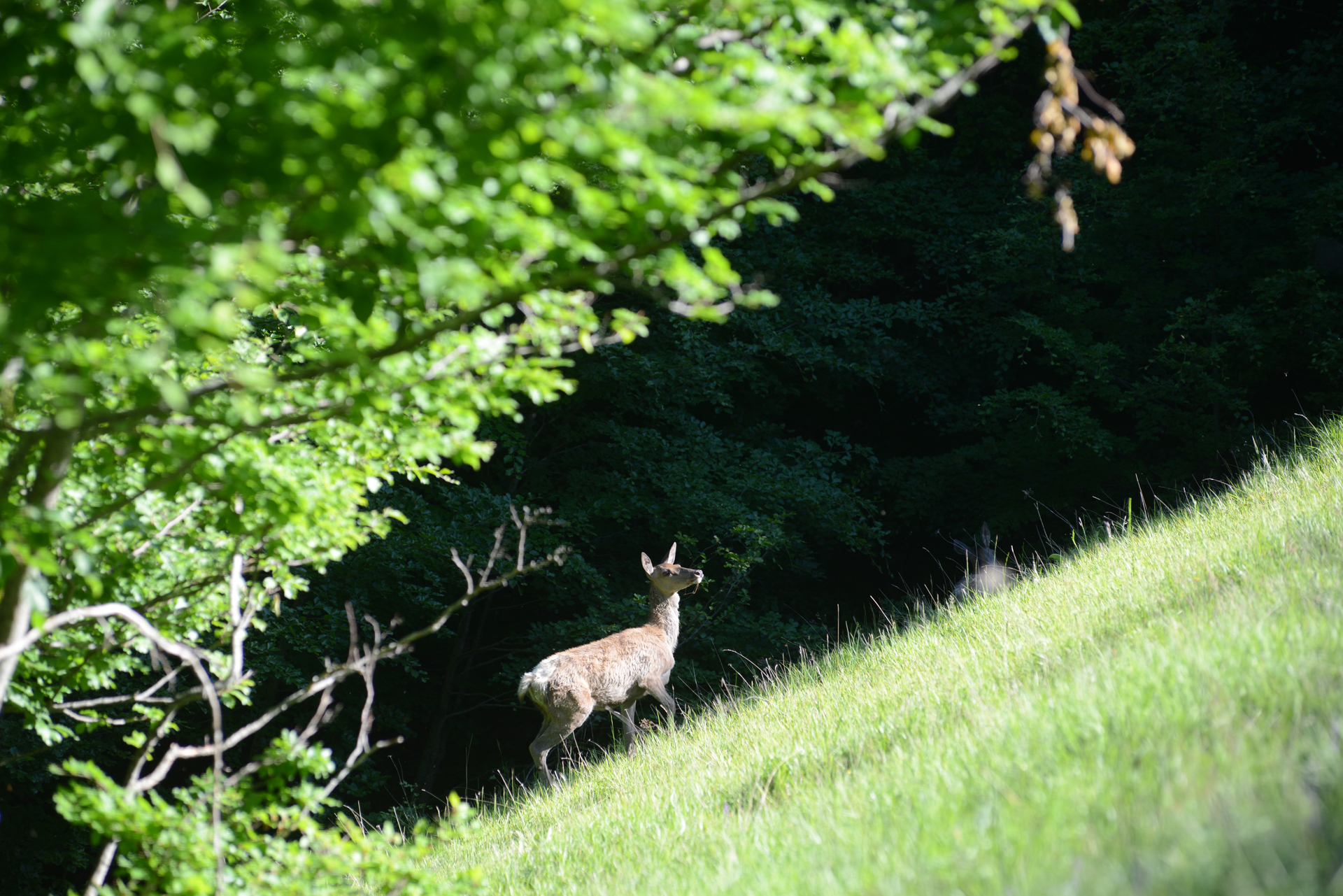
Red deer at Val di Rose
May 30th, Saturday
Get up early again. It is still dark when I leave the building. Where the gravel road from Casale delle Campitelle leads into Villetta Barrea two foxes cross. It is still night, when I pass the intersection to „Camosciara“. In the beam of my headlight I get a glimpse of a cat on the left hand sight of the road.
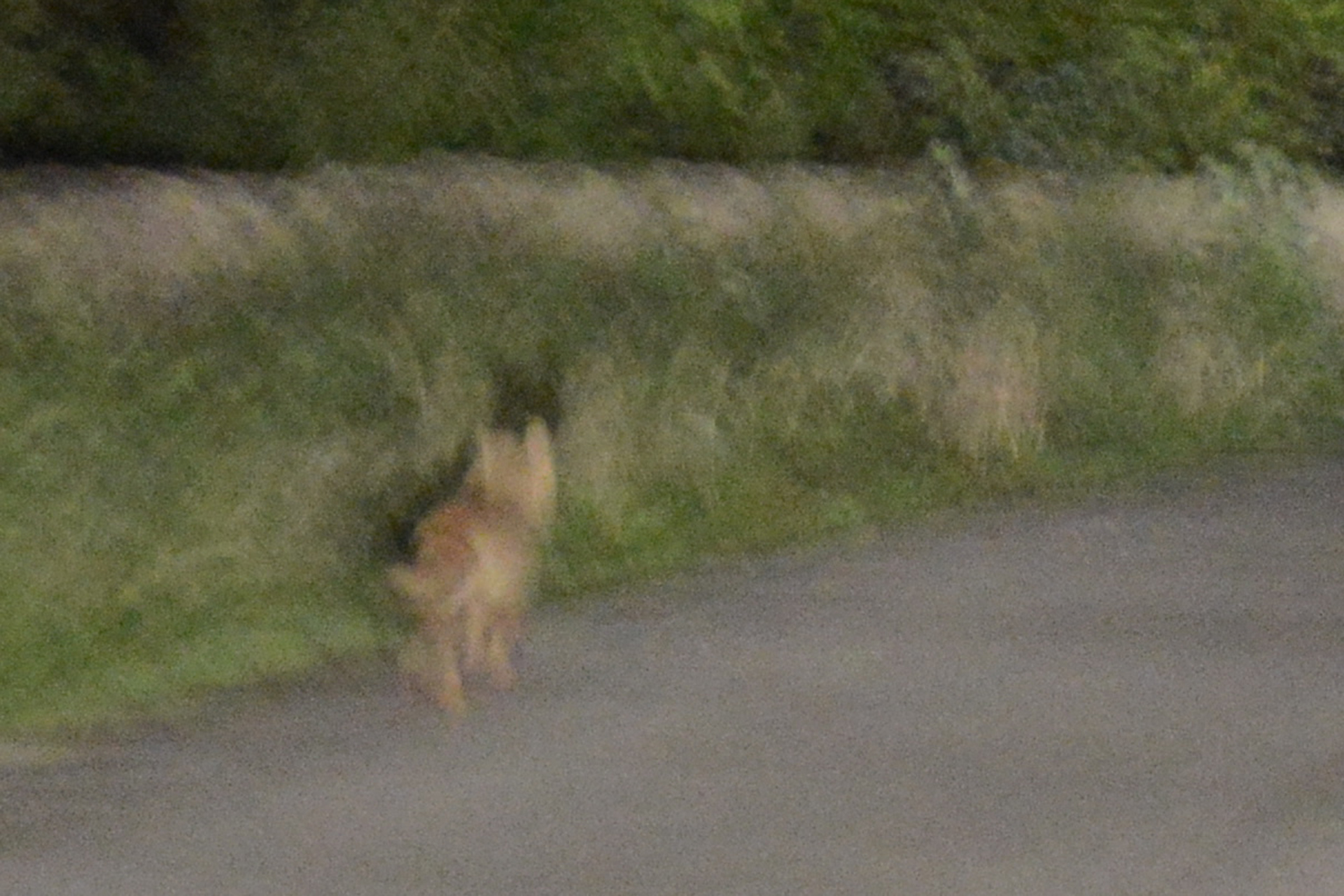
A wild cat? The tail appears to be thick. Tail rings are visible with a bit of imagination. No black on the sole („Nehring’scher Fleck: Less than half of the sole is black in wildcats; in domestic cats more than half is black.)
I reduce speed and manage to take a few photos. The quality of the pictures is not really good and don’t help much with the identification. The next settlement, Villetta Barrea, is 2,5 Kilometers away. Chances are, that it was a wild cat.
Just a few meters further a marten shows up and pauses facing me. I can clearly see a white throat patch which speaks for a stone marten.
On the road before Gioia vecchio I see three different hares along the road. Get pictures of two of them, the one hopping along the road, the other as it tries to hide below the embankment.
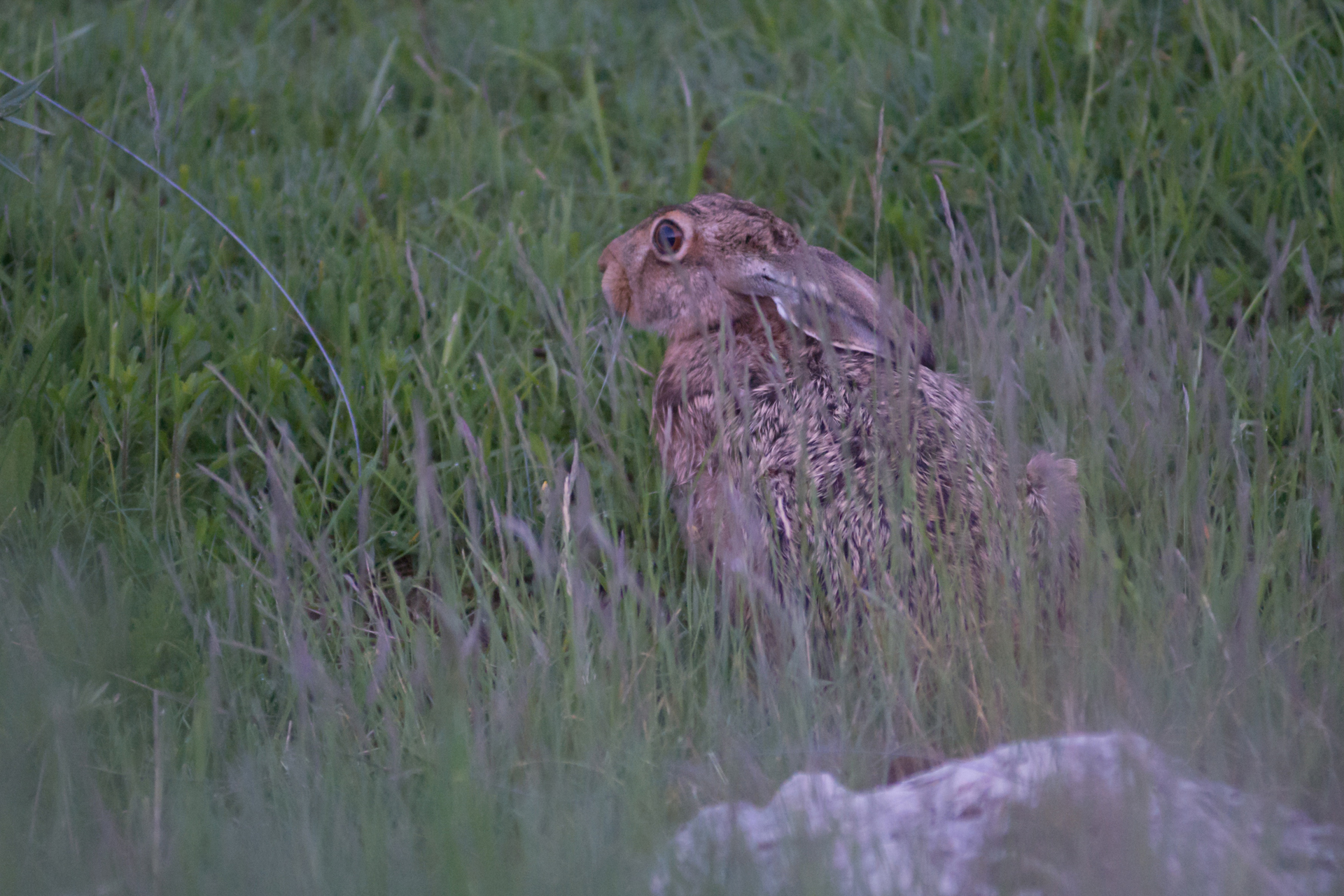
Hare trying to hide
Again at Gioia vecchio before sunrise. Stay there until around 8: again no luck with the bears. But the scenery is great. And it’s fun to talk to fellow wanna-be-bear-watchers.
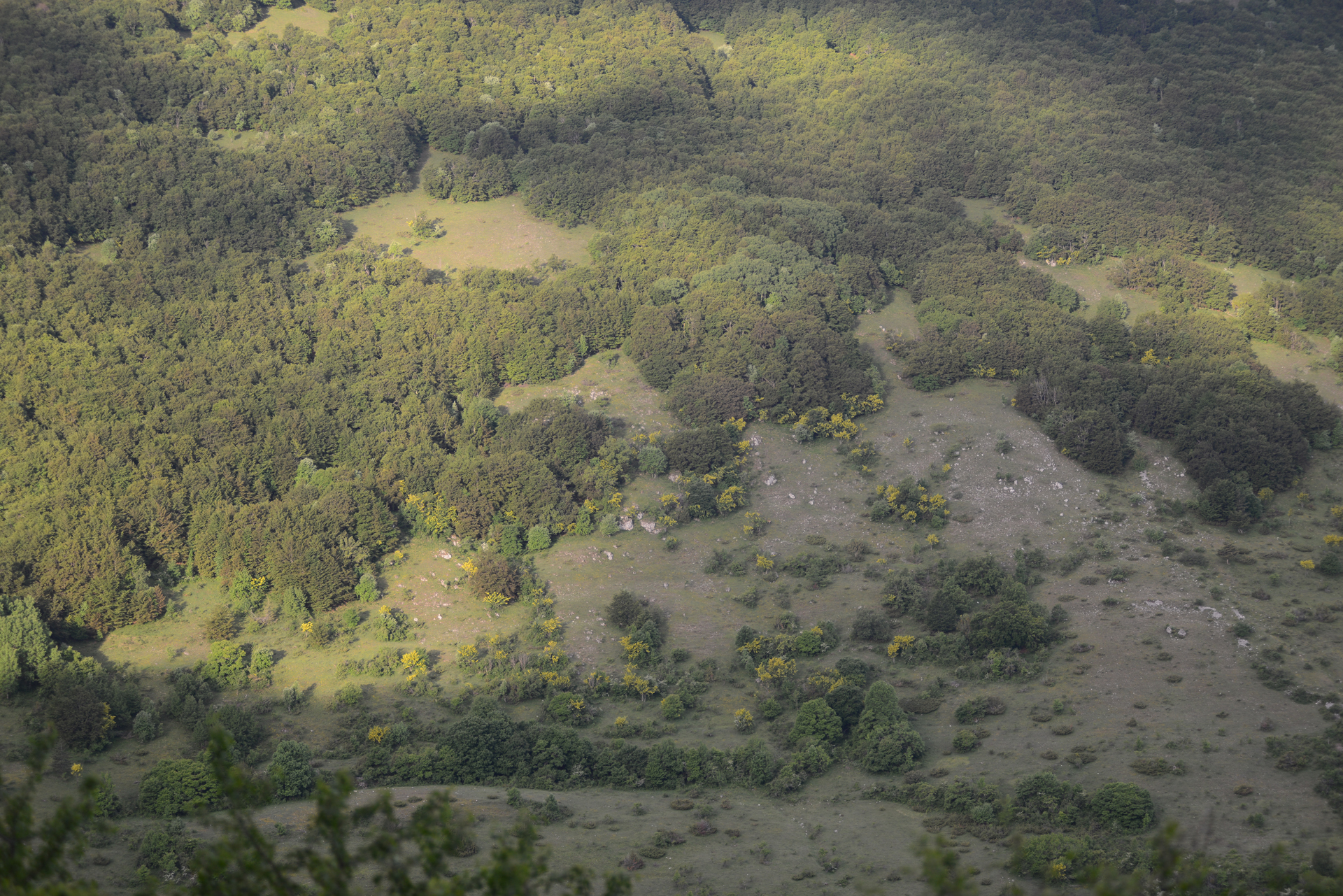
The slope opposite Gioia vecchio: usually good habitat for bears in spring
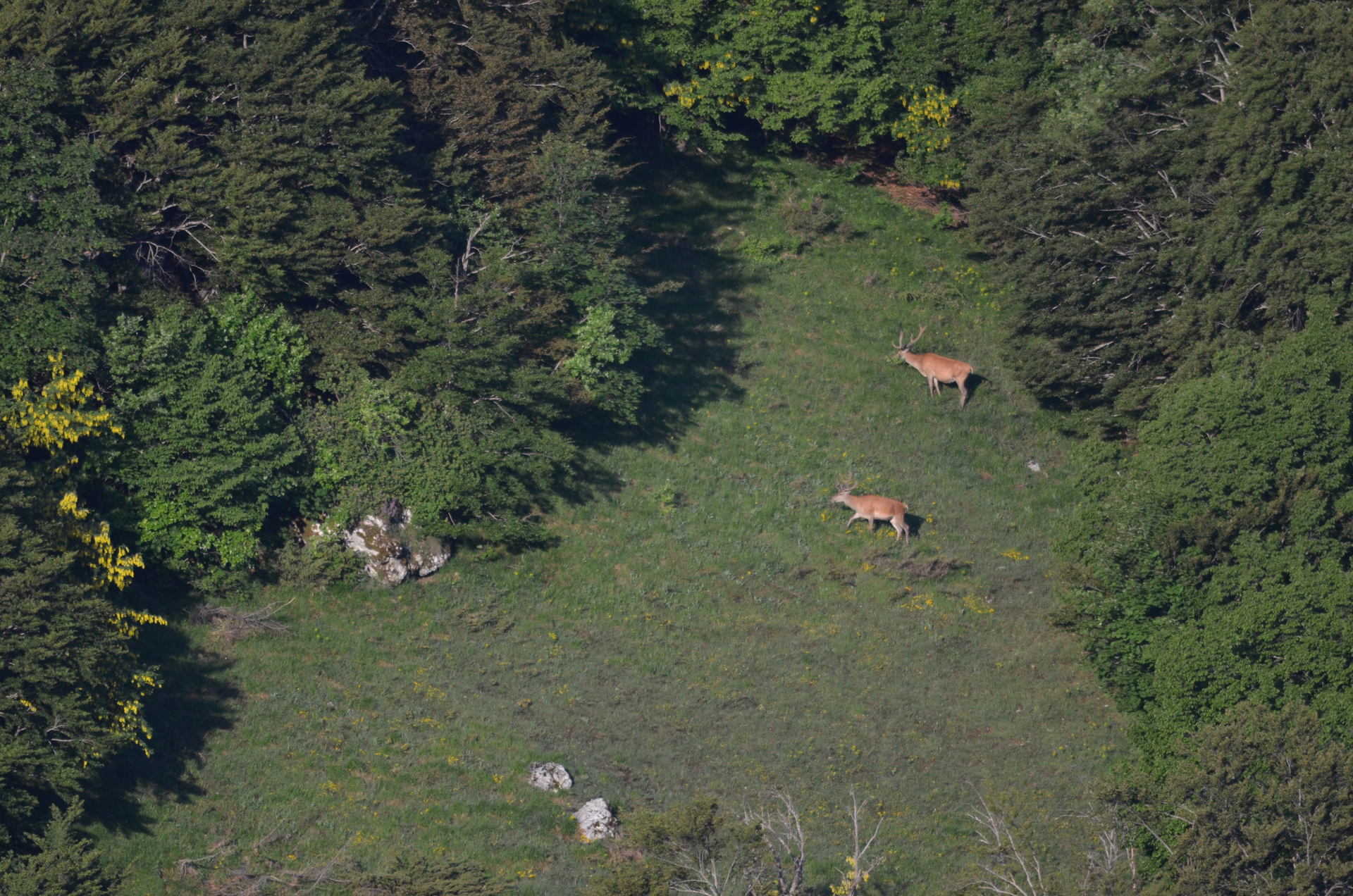
Red deer was the most common wild animal at the lookout.
May 31st, Sunday
5th attempt to get the bears at Gioia Vecchio.
On the way I see again something belonging to the weasel family. Even though it is most probable that it is again the stone marten, my intuition tells me something else. It seems a bit smaller. Could it be a polecat? I never see a face and it’s gone in a second. So I don’t know. – Polecats do occur in Abruzzo National Park.
But a cat, a stone marten and something weasellike in two mornings at the same spot: That’s something! I look at the place and notice that the valley of the river Sangro forms kind of a gorge at „Camosciara“. So maybe animals that move along the river have only a few places that they can use for passing through. Maybe it’s worthwhile to sit here in the morning and wait for more wildlife.
After breakfast we hike at Monte Marsicano, starting from Opi. The trail leads initially through pastures, later through a quaint beech forest.
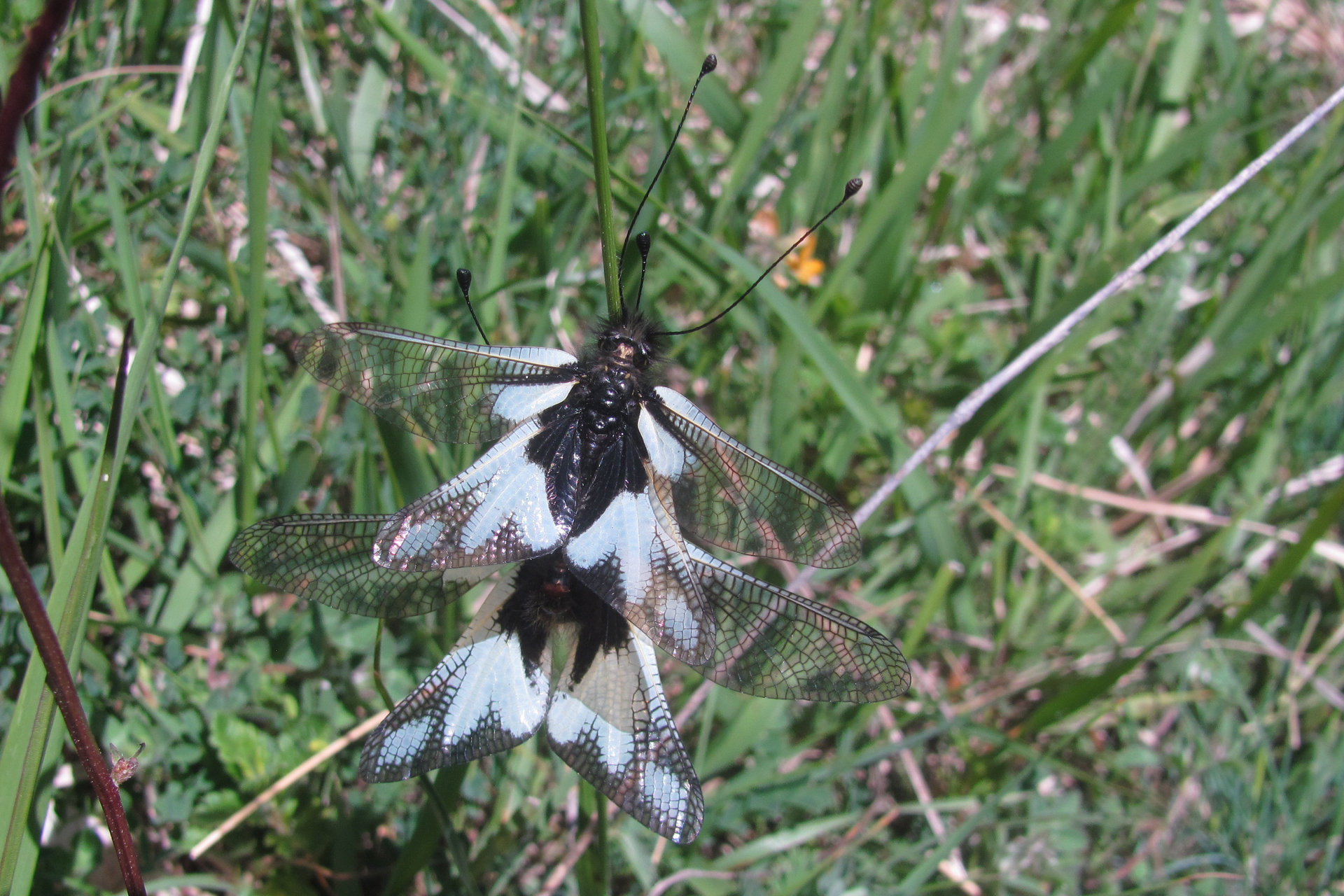
Owly Sulphurs, (Libellen-Schmetterlingshaft) – here a mating pair – were seen in great numbers at Monte Marsicano.
Because of a thunderstorm in the afternoom we don’t manage to reach the summit, at least we get to the upper treeline. The alpine area is spectacularly mustered with low-lying juniper patches.
While waiting for my family to catch up with me, I scan the slopes with my binoculars. It takes only a few seconds until I see a female red deer with a calf that seems to be only a few days old.
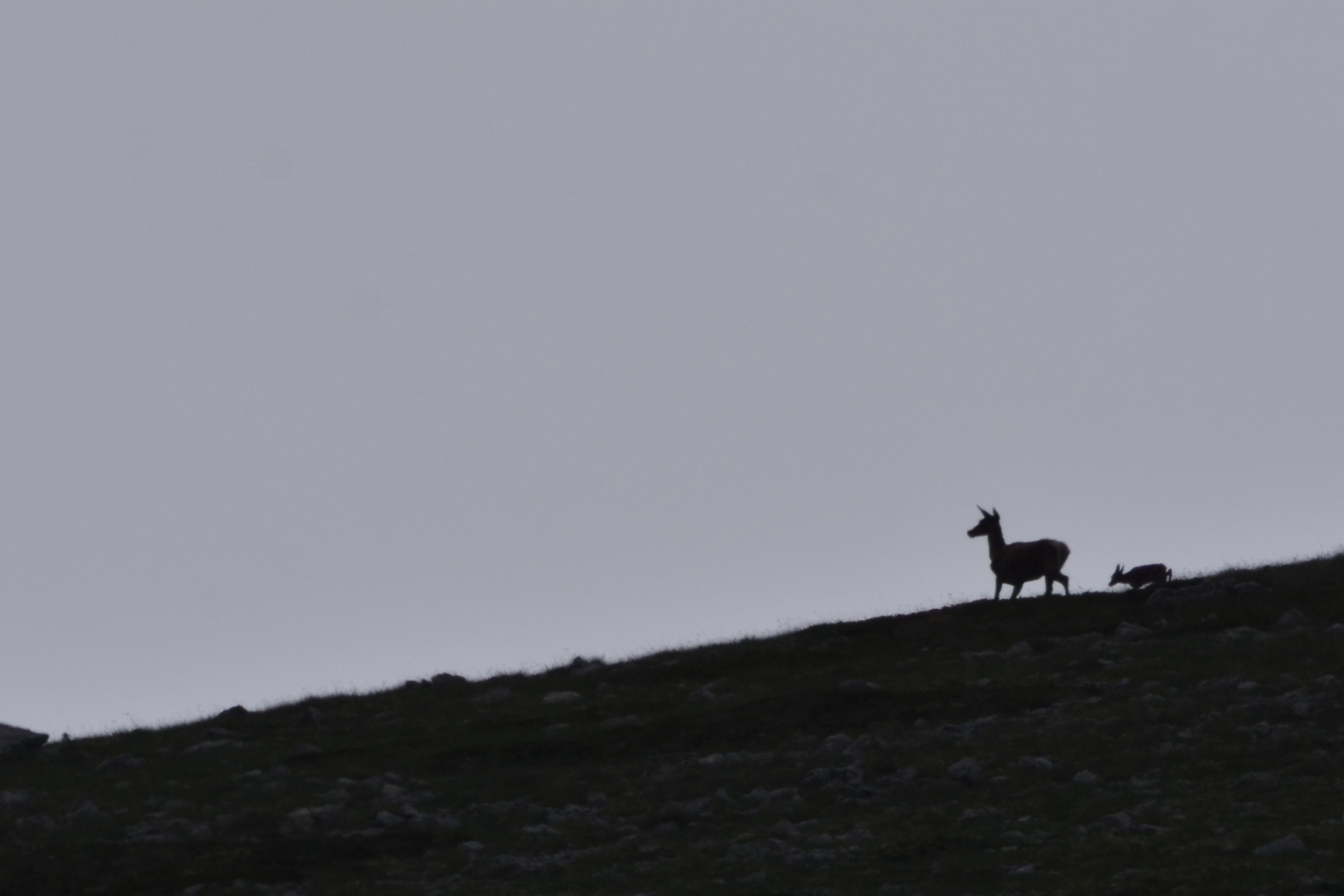
Red deer – mum and calf
I am quite surprised to see female red deer with calves at different elevations. The one at Civitella Alfedena was at 1200 m; this one I guess at 2000 m. It seems they don’t have a clear strategy to avoid predators. This one has chosen the open habitat of the alpine area to have a chance to outrun wolves. And the doe reacts to my appearance as well: I am hundreds of meters away, it still prefers to leave the area.
Later I meet Paolo again. He invites me to view an amateur video of a client on his smartphone. It shows a red deer doe detering a single wolf to go after its calf. Watch here: Wolf hunting red deer calf
June 1st, Monday
One last time at at Gioia vecchio to see bears – 6th attempt. Again no luck. But it is still worthwhile. Later I am told that 2015 was the first year in many years that no bears were seen at Gioia vecchio at this time of the year. I also notice that animals in other places behave differently. Maybe it has to do with the extrem hot weather this year.
Birds seen
| english | scientific | german | seen at |
| alpine accentor | (Prunella collaris) | Alpenbraunelle | Val di Rose (alpine) |
| barn swallow | (Hirundo rustica) | Rauchschwalbe | Casale delle Campitelle, Civitella Alfedena |
| black redstart | (Phoenicurus ochruros) | Hausrotschwanz | Val di Rose |
| blue tit | (Cyanistes caeruleus) | Blaumeise | |
| chiffchaff | (Phylloscopus collybita) | Zilpzalp | Val di Rose (forest) |
| cirl bunting | (Emberiza cirlus) | Zaunammer | Casale delle Campitelle, Gioia vecchio |
| coal tit | (Periparus ater) | Tannenmeise | Gioia vecchio |
| common chaffinch | (Fringilla coelebs) | Buchfink | Val di Rose (forest) |
| common cuckoo | (Cuculus canorus) | Kuckuck | Casale delle Campitelle, Val di Rose (forest) |
| common firecrest | (Regulus ignicapilla) | Sommergoldhähnchen | Val di Rose (forest) |
| common redstart | (Phoenicurus phoenicurus) | Gartenrotschwanz | Casale delle Campitelle |
| common starling | (Sturnus vulgaris) | Star | |
| common swift | (Apus apus) | Mauersegler | |
| common wood pigeon | (Columba palumbus) | Ringeltaube | Val di Rose (forest) |
| eastern carrion crow | (Corvus corone orientalis) | Nebelkrähe | Casale delle Campitelle |
| European blackbird | (Turdus merula) | Amsel | Casale delle Campitelle, abandoned fields at Civitella Alfedena |
| Eurasian blackcap | (Sylvia atricapilla) | Mönchsgrasmücke | abandoned fields at Civitella Alfedena |
| European goldfinch | (Carduelis carduelis) | Distelfink | Casale delle Campitelle |
| Eurasian jay | (Garrulus glandarius) | Eichelhäher | Casale delle Campitelle; Val di Rose (forest) |
| Eurasian nuthatch | (Sitta europaea) | Kleiber | Pescasseroli |
| European green woodpecker | (Picus viridis) | Grünspecht | Casale delle Campitelle |
| European robin | (Erithacus rubecula) | Rotkehlchen | Val di Rose |
| European stonechat | (Saxicola rubicola) | Schwarzkehlchen | Valley north of Opi |
| Eurasian wren | (Troglodytes troglodytes) | Zaunkönig | Gioia vecchio, Val di Rose (forest) |
| grey wagtail | (Motacilla cinerea) | Gebirgsstelze | |
| golden eagle | (Aquila chrysaetos) | Steinadler | Val di Rose, Gioia vecchio |
| hoopoe | (Upupa epops) | Wiedehopf | Casale delle Campitelle; Gioia vecchio |
| house sparrow | (Passer domesticus) | Haussperling | |
| nightingale ? | (Luscinia megarhynchos) | Nachtigall | Casale delle Campitelle |
| red-backed shrike | (Lanius collurio) | Neuntöter | Valley north of Opi |
| rock bunting | (Emberiza cia) | Zippammer | along the road near Gioia vecchio |
| serin ? | (Serinus serinus) | Girlitz | |
| red-billed chough | (Pyrrhocorax pyrrhocorax) | Alpenkrähe | Val di Rose (alpine) |
| song thrush | (Turdus philomelos) | Singdrossel | |
| tree pipit | (Anthus triviali)s | Baumpieper | Val di Rose (alpine) |
| wheatear | (Oenanthe oenanthe) | Steinschmätzer | Val di Rose (alpine) |
Reptiles seen
| Common wall lizard | (Podarcis muralis), | Mauereidechse | abandoned fields at Civitella Alfedena |
| Western green lizard | (Lacerta bilineata), | Westliche Smaragdeidechse | Val di Rose |
Conspicuous insects
| Owly Sulphur | (Libelloides coccajus), | Libellen-Schmetterlingshaft | abandoned fields at Civitella Alfedena and at Monte Marsicano |

